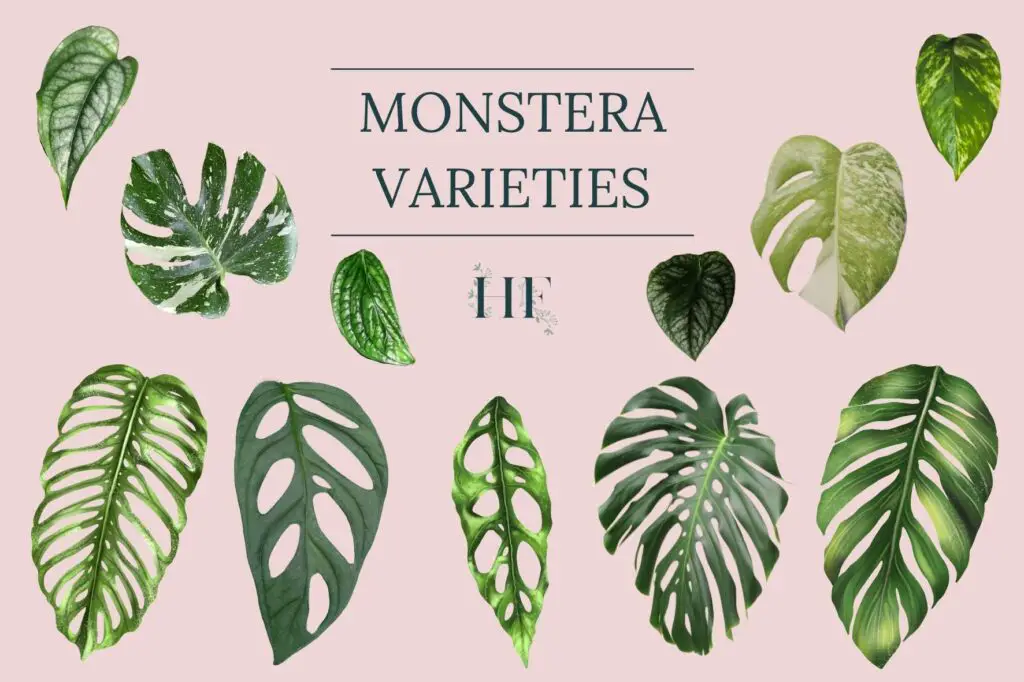Monstera Deliciosa is the most popular houseplant among the Monstera family, but it isn’t the only one you can get. Wondering how many Monstera varieties or types are out there?
In this blog post, I will go through the most popular monstera varieties, including the mesmerizing Variegata cultivars.
Monstera Varieties
Botanically speaking, Monstera is a genus of 49 species of flowering plants in the arum family, Araceae, native to tropical regions of the Americas.
However, as of July 2020 Plants of the World Online recognises 55 accepted taxa (of 49 species and 6 infraspecific names). More about these 6 cultivars at the end!
The best-known representative of the genus is Monstera Deliciosa, but that’s not the only Monstera that you can get as a houseplant.
The most popular monstera varieties include:
Note: Some of the Monstera species listed here are actually subspecies, and others (especially when talking about variegation) are cultivars.
1) Monstera Deliciosa (Swiss Cheese Plant)
Monstera Deliciosa is also known as the Swiss Cheese Plant, Fruit Salad Plant, Mexican Breadfruit, Ceriman, and Windoleaf, amongst others.
The scientific name Monstera Deliciosa translates to “delicious monster,” this name was given in honour of the plant’s sweet fruit and large, broad spreading leaves.
Monstera Deliciosa Care
| MONSTERA SPECIES | Monstera Deliciosa |
|---|---|
| Plant Type | Evergreen vine, flowering plant. |
| Geographic Origin | Mexico, Panama. |
| Plant Size | Up to 66 feet (20m) tall outdoors, 6 to 10 feet (1.8 to 3m) tall indoors. |
| Flower | Cream-white spathe with a yellowish-white spadix. |
| USDA Hardiness Zones | 10 to 12. H1B in the UK. |
| Soil Type | Well-drained soil. |
| Light Requirements | Bright indirect sunlight, partial shade. |
| Humidity Levels | 40 to 60% |
| Temperature Needs | 68 to 86°F (20 to 30°C). |
| Watering Needs | Medium (moist soil). |
| Feeding Needs | Fertilize once a month during spring and summer. |
| Toxicity | Toxic to humans, dogs, cats, and other pets. |
Monstera Deliciosa Facts
Monstera Deliciosa has heart-shaped, leathery, dark green leaves that are soft to the touch.
These leaves can grow very large too, from 9.8 to 35.4 inches (25 to 90cm) in length and 5.9 to 29.5 inches (15 to 75cm) in width.
Also, Monstera Deliciosa’s leaves grow holes or slits called fenestration (an opening in a leaf surface) on mature plants. This trait is also common in other Monstera varieties.
It flowers in its natural habitat (or in greenhouses) and produces edible fruit.
See these Monstera Deliciosa selections on Etsy.
Read also: 15 Surprising Monstera Deliciosa Facts [With Images].
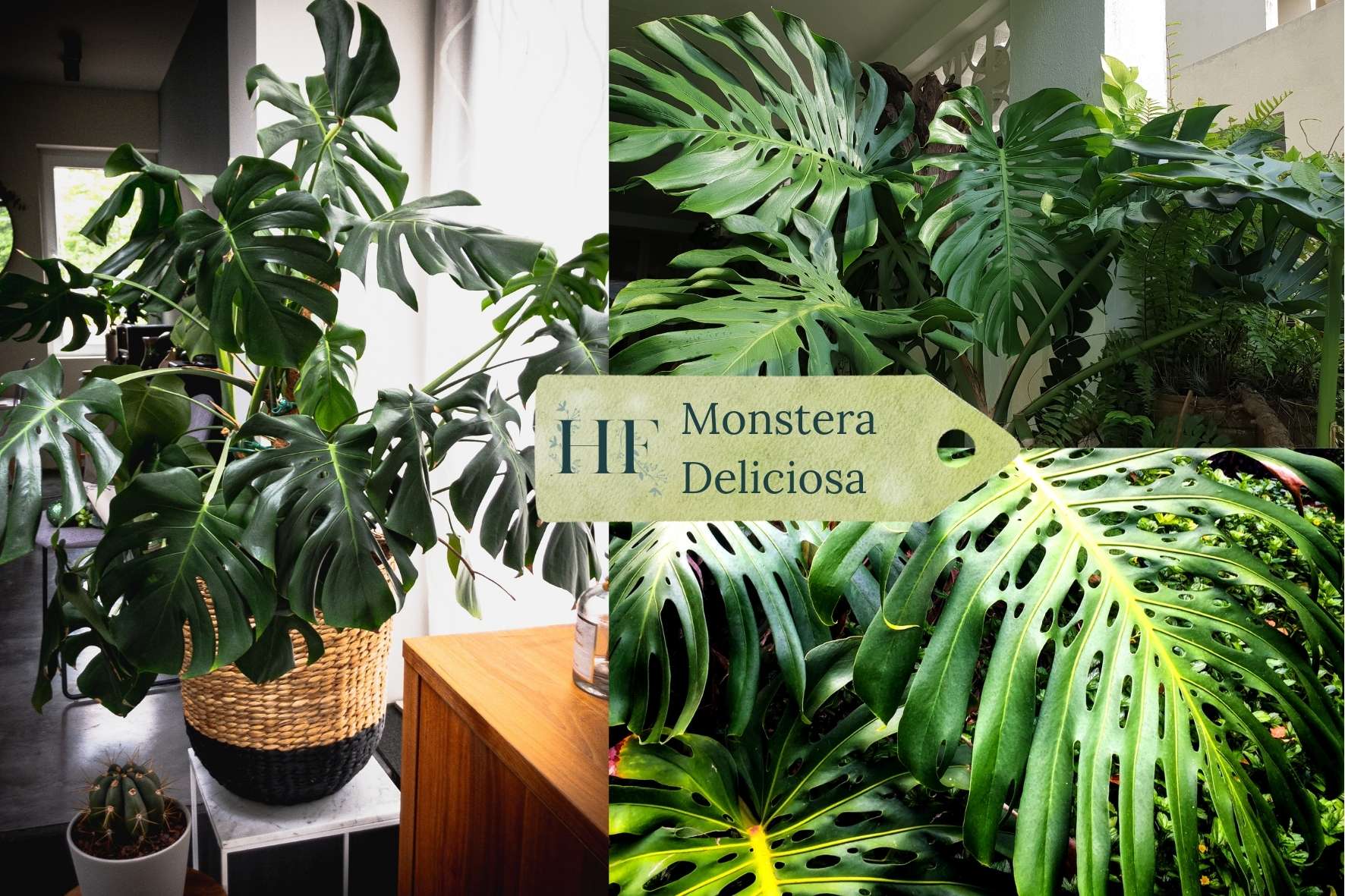
2) Monstera Adansonii (Swiss Cheese Vine)
Monstera Adansonii is also known as Swiss Cheese Vine and Swiss Cheese Plant (sharing Monstera Deliciosa’s common name).
Monstera Adansonii Care
| MONSTERA SPECIES | Monstera Adansonii |
|---|---|
| Plant Type | Evergreen vine, flowering plant. |
| Geographic Origin | South America, Central America, West Indies islands. |
| Plant Size | Up to 13 feet (4m) tall outdoors, 3 to 5 feet (0.9 to 1.5m) tall indoors. |
| Flower | White, yellow or rose spathe with green, white or yellow spadix. |
| USDA Hardiness Zones | 11b to 12. |
| Soil Type | Well-drained soil. |
| Light Requirements | Bright indirect sunlight, partial sun. |
| Humidity Levels | 40 to 60% |
| Temperature Needs | 68 to 86°F (20 to 30°C). |
| Watering Needs | Medium (moist soil). |
| Feeding Needs | Fertilize once a month during spring and summer. |
| Toxicity | Toxic to humans, dogs, cats, and other pets. |
Monstera Adansonii Facts
Monstera Adansonii has smaller, narrower oval-shaped leaves and shorter stems that make the whole plant feel much smaller than Monstera Deliciosa.
The leaves are thick, waxy texture, and contain large oval-shaped holes. Its leaf fenestrations remain closed (i.e., no slits), but they are quite large, taking up about 50% of the leaf surface.
Indoors, those leaves are the size of your hand, but outdoors they grow bigger. Its leaves can reach almost 14 inches (35.6cm) in length. In young plants, however, the leaf length is usually no more than 8 inches (20cm). Still, not as big as Monstera Deliciosa’s.
Adansonii grows as a vine. It also flowers in its natural habitat (or in greenhouses) and produces fruit.
See Monstera Adansonii on Etsy.
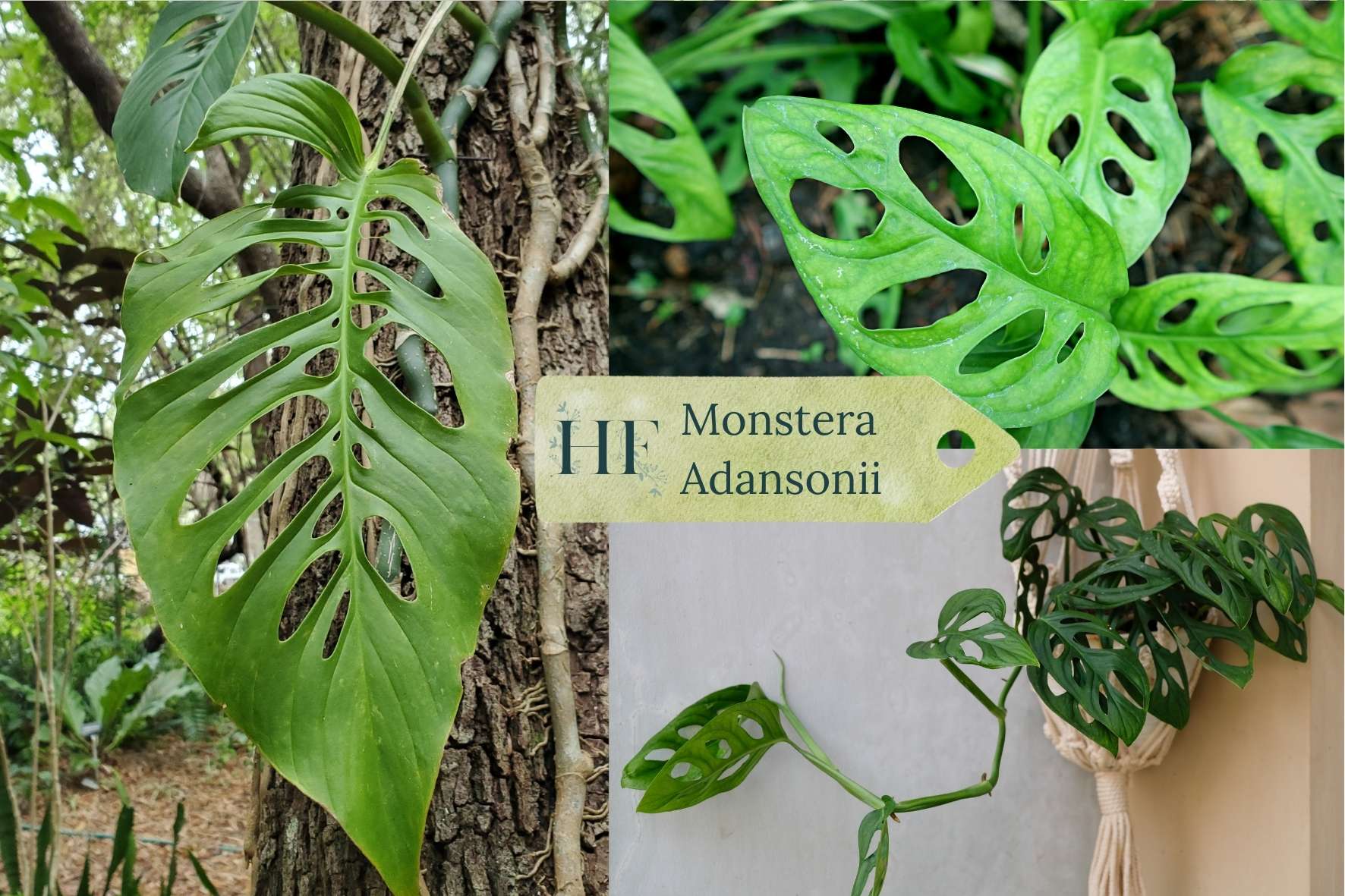
3) Monstera Borsigiana
Monstera Borsigiana is a subspecies of Monstera Deliciosa.
Monstera Borsigiana Care
| MONSTERA SPECIES | Monstera Borsigiana |
|---|---|
| Plant Type | Evergreen vine. |
| Geographic Origin | Mexico. |
| Plant Size | 2 to 4 feet (0.6 to 1.2m) tall indoors. |
| Flower | None. |
| USDA Hardiness Zones | 10 to 11. |
| Soil Type | Well-drained soil. |
| Light Requirements | Bright indirect sunlight. |
| Humidity Levels | 40 to 60% |
| Temperature Needs | 68 to 86°F (20 to 30°C). |
| Watering Needs | Medium (moist soil). |
| Feeding Needs | Fertilize once a month during spring and summer. |
| Toxicity | Toxic to humans, dogs, cats, and other pets. |
Monstera Borsigiana Facts
It has smaller leaves, thinner stems, and longer internodes (the leaves grow further apart on the stem) than Monstera Deliciosa.
It can be difficult to distinguish between the two, especially when they are young.
Also, Borsigiana grows faster than Deliciosa.
See Monstera Borsigiana on Etsy.
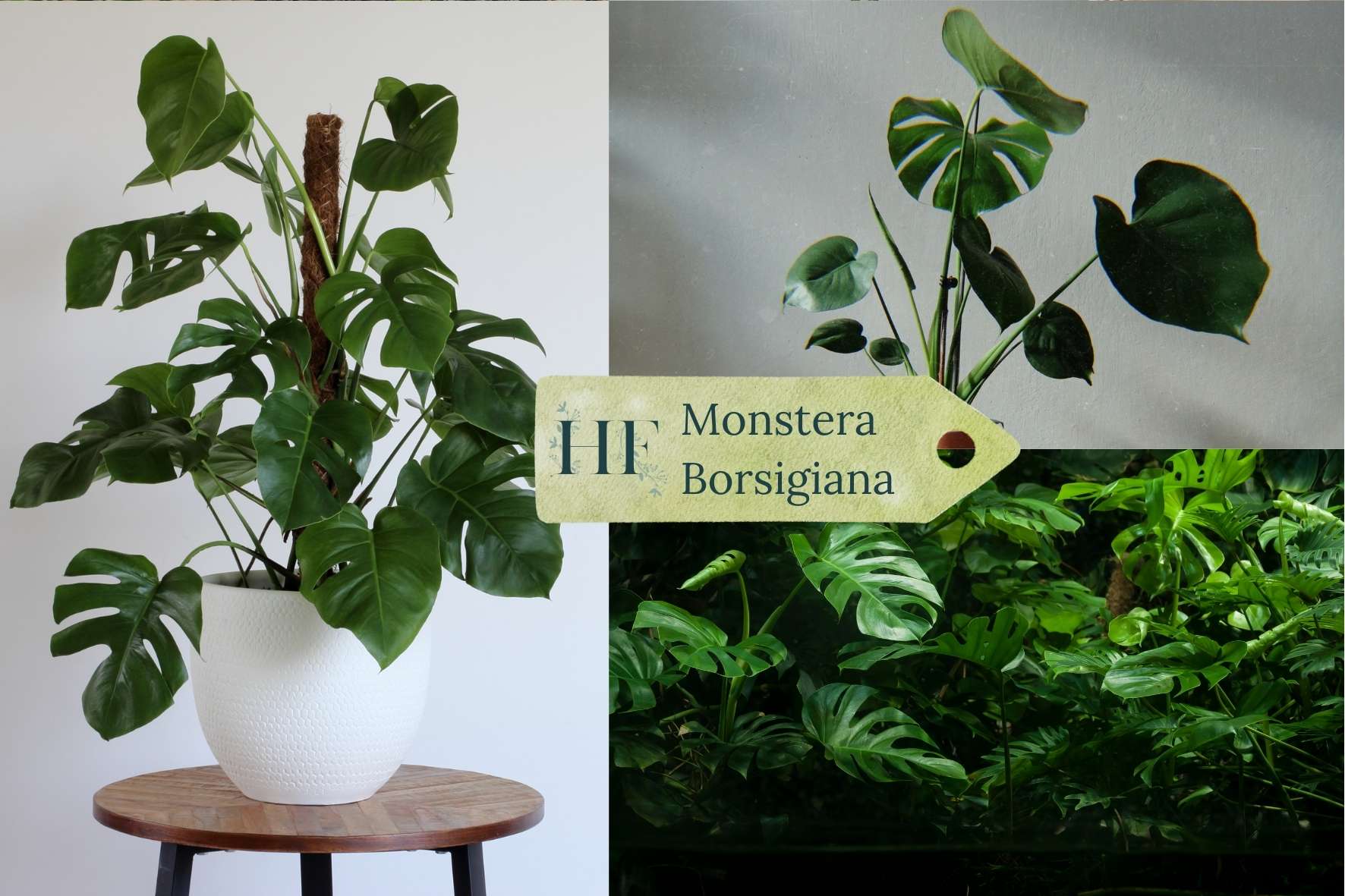
4) Monstera Dubia
Monstera Dubia is another variety that is not commonly known.
Monstera Dubia Care
| MONSTERA SPECIES | Monstera Dubia |
|---|---|
| Plant Type | Evergreen vine, flowering plant. |
| Geographic Origin | Central America, South America. |
| Plant Size | Up to 10 feet (3m) tall outdoors, and 3 to 6 feet (0.9 to 1.8m) tall indoors. |
| Flower | Salmon pink spathe with a cream spadix. |
| USDA Hardiness Zones | 9 to 11. |
| Soil Type | Loamy, well-drained soil with acidic or neutral pH. |
| Light Requirements | Partial sun. |
| Humidity Levels | 40 to 60% |
| Temperature Needs | 68 to 86°F (20 to 30°C). |
| Watering Needs | Medium (moist soil). |
| Feeding Needs | Fertilize once a month during spring and summer. |
| Toxicity | Toxic to humans, dogs, cats, and other pets. |
Monstera Dubia Facts
In its juvenile form (what you are likely to see as a houseplant), Monstera Dubia has smaller heart-shaped leaves with patterned light and dark green colouration.
As it grows, its leaves alternate between the left and right sides of the stem, giving it a neat and tidy appearance. The leaves also stay closer to the climbing surface like other creeping vines. It also grows as a vine.
Monstera Dubia reveals its mature form once it reaches up high enough to get lots of light. A mature Dubia plant’s leaves grow larger, turn deep green, and develop fenestrations. However, this is unlikely to happen when raised as a houseplant.
Contrary to popular belief, Monstera Dubia blooms in its natural habitat.
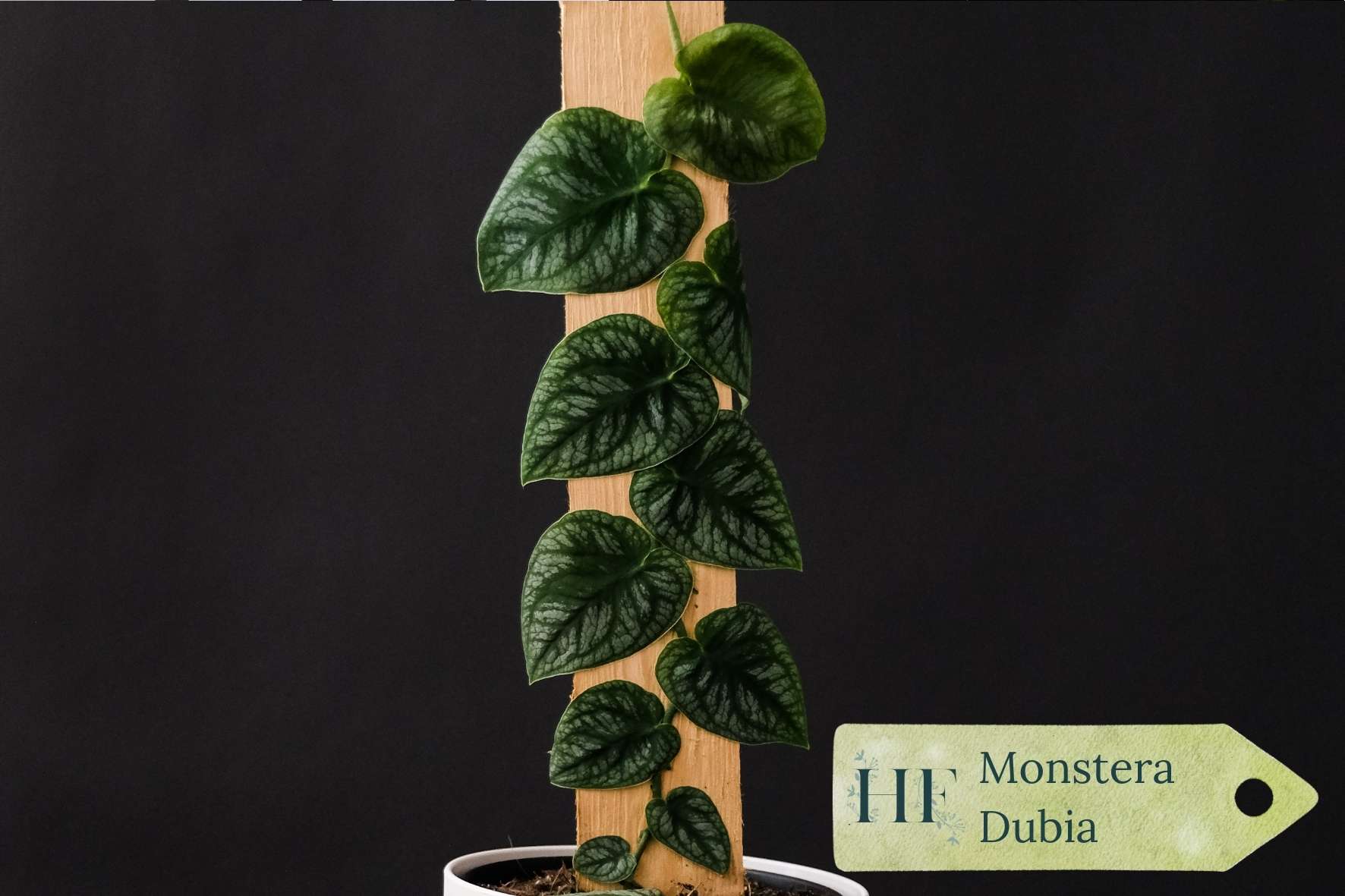
5) Monstera Obliqua
Monstera Obliqua is one of the rarest varieties.
Monstera Obliqua Care
| MONSTERA SPECIES | Monstera Obliqua |
|---|---|
| Plant Type | Evergreen vine, flowering plant. |
| Geographic Origin | Central America, South America. |
| Plant Size | 6 to 10 feet (1.8 to 3m) tall outdoors. |
| Flower | Green spathe with a greenish-white or yellow spadix. |
| USDA Hardiness Zones | 9 to 11. |
| Soil Type | Loamy, well-drained soil. |
| Light Requirements | Bright indirect sunlight, partial sun. |
| Humidity Levels | 40 to 60% |
| Temperature Needs | 68 to 86°F (20 to 30°C). |
| Watering Needs | Medium (moist soil). |
| Feeding Needs | Fertilize once a month during spring and summer. |
| Toxicity | Toxic to humans, dogs, cats, and other pets. |
Monstera Obliqua Facts
It is often confused with Monstera Adansonii. However, Obliqua’s holes are much bigger. Its fenestration is so pronounced that it looks like there is more hole than leaf (i.e., it has more empty space – around 90% – than the leaf surface).
The other difference between Obliqua and Adansonii is the leaf sturdiness. Adansonii’s leaves are thicker and sturdier, while Obliqua’s leaves are much more delicate.
However, a juvenile Obliqua plant is nearly indistinguishable from an Adansonii plant, as their fenestration is not fully developed yet.
Also, Obliqua’s growth rate is slow, reducing its availability. Like Adansonii, it also grows as a vine.
See these Monstera Obliqua selections on Etsy.
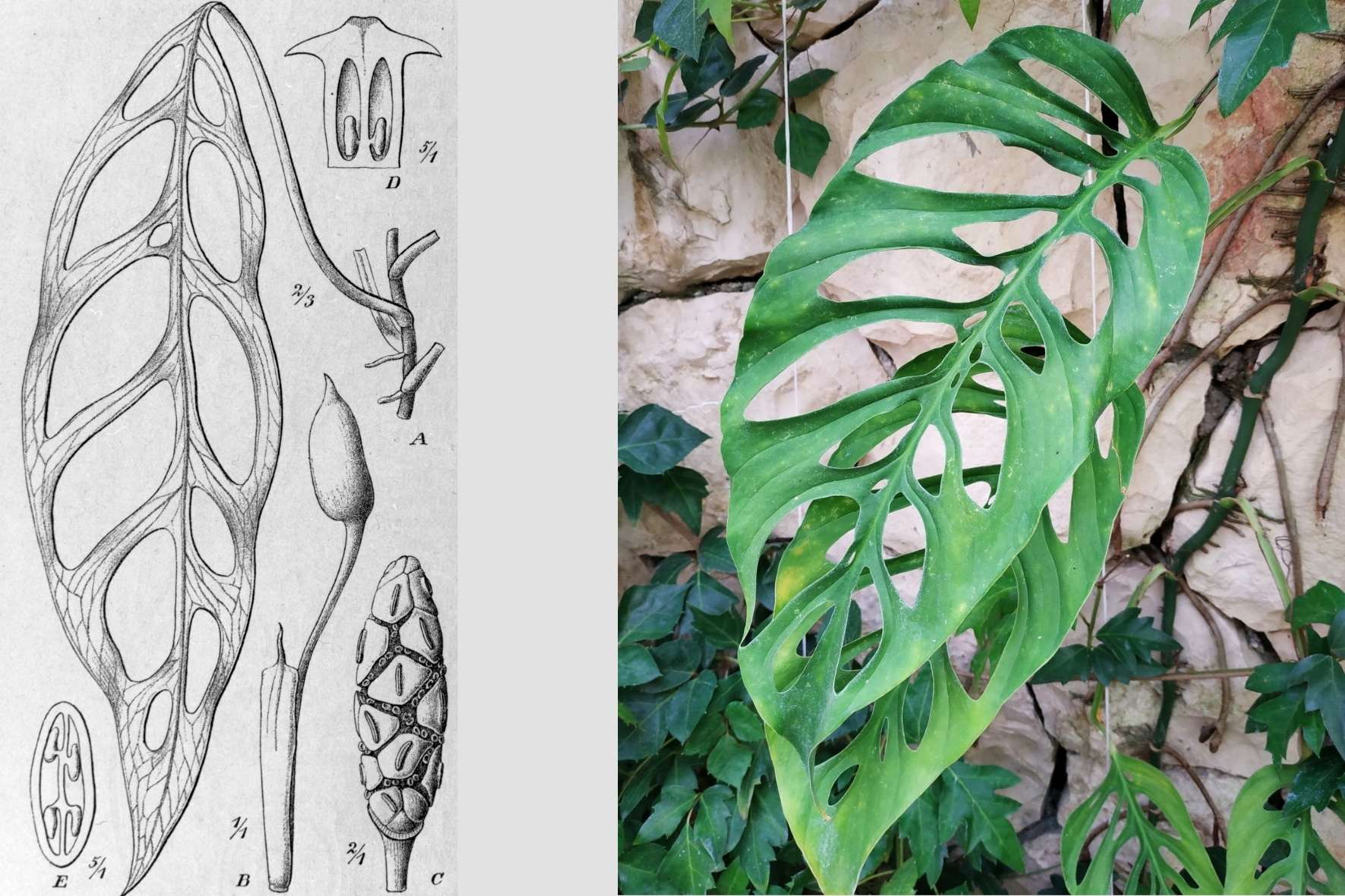
6) Monstera Pinnatipartita
Monstera Pinnatipartita Care
| MONSTERA SPECIES | Monstera Pinnatipartita |
|---|---|
| Plant Type | Evergreen vine, flowering plant. |
| Geographic Origin | Central America, South America. |
| Plant Size | Up to 66 feet (20m) outdoors, and 4 to 6 feet (1.2 to 1.8m) tall indoors. |
| Flower | White spathe and spadix. |
| USDA Hardiness Zones | 11 to 12. |
| Soil Type | Well-drained soil with an acidic to neutral pH. |
| Light Requirements | Partial sun. |
| Humidity Levels | 50 to 60% |
| Temperature Needs | 68 to 86°F (20 to 30°C). |
| Watering Needs | Medium (moist soil). |
| Feeding Needs | Fertilize once a month during spring and summer. |
| Toxicity | Toxic to humans, dogs, cats, and other pets. |
Monstera Pinnatipartita Facts
Like the Deliciosa, Monstera Pinnatipartita has a more compact stem growth with a shorter internode spacing, which means it grows less like a vine.
The leaves are large, glossy and deep green. Also, the foliage is less heart-shaped.
Pinnatipartita’s leaves become highly fenestrated when mature, its deep slits run from the leaf edge all the way to the centre. Those fanned-out leaves give it a palm vibe.
This variety also flowers in its natural habitat, producing fruit.
See these Monstera Pinnatipartita selections on Etsy.
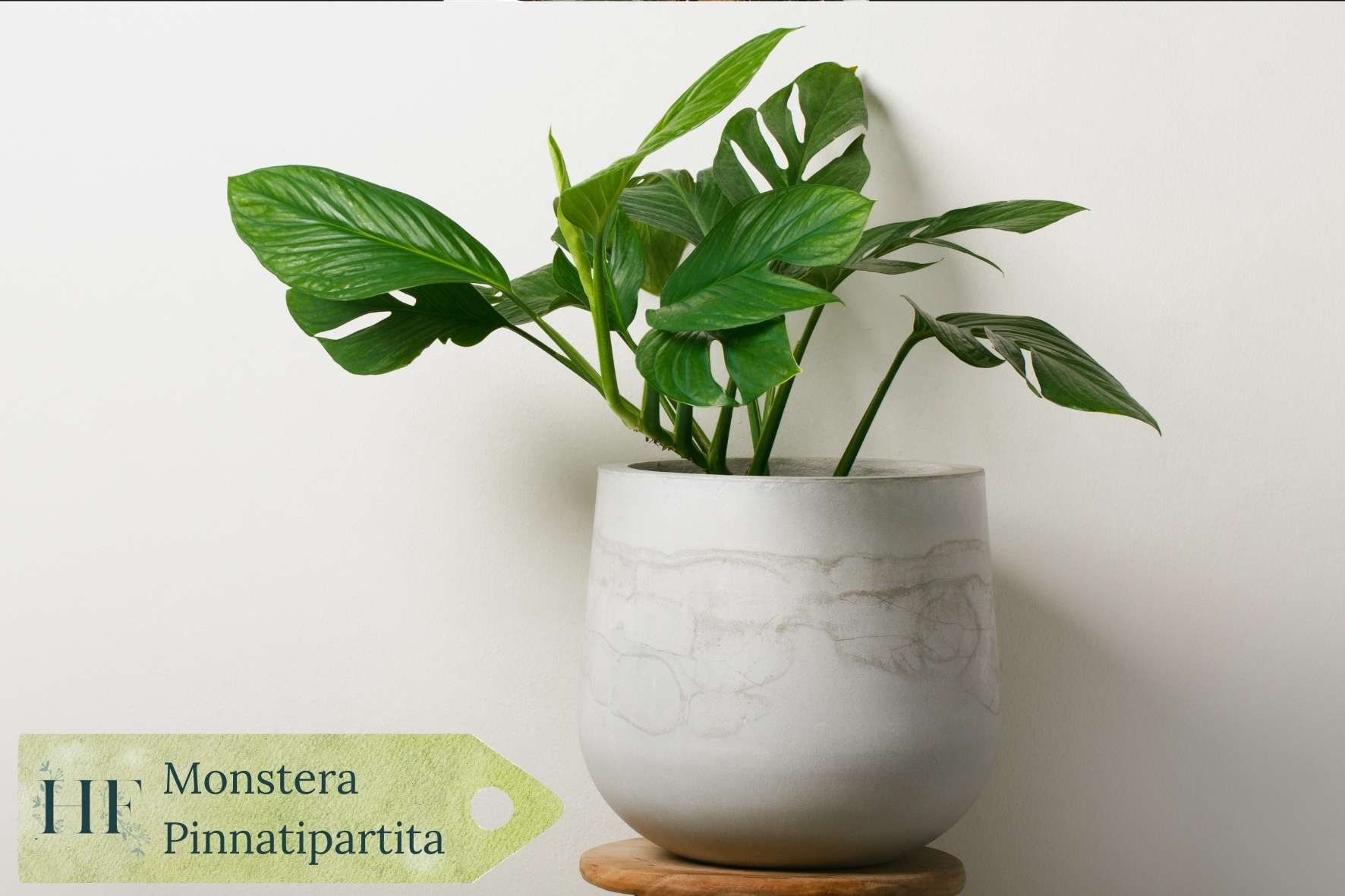
7) Monstera Siltepecana (Silver Monstera)
Monstera Siltepecana, also known as Silver Monstera, is another rare variety of Monstera.
Monstera Siltepecana Care
| MONSTERA SPECIES | Monstera Siltepecana |
|---|---|
| Plant Type | Evergreen vine, flowering plant. |
| Geographic Origin | Mexico, Central America. |
| Plant Size | 6 to 8 feet (1.8 to 2.4m) tall. |
| Flower | Creamy white spathe and slightly darker spadix, with black imprints on it. |
| USDA Hardiness Zones | 9 to 11. |
| Soil Type | Well-drained soil, with acidic or neutral pH. |
| Light Requirements | Bright indirect sunlight, partial shade. |
| Humidity Levels | 50 to 60% |
| Temperature Needs | 68 to 86°F (20 to 30°C). |
| Watering Needs | Medium (moist soil). |
| Feeding Needs | Fertilize once a month during spring and summer. |
| Toxicity | Toxic to humans, dogs, cats, and other pets. |
Monstera Siltepecana Facts
Monstera Siltepecana is a small and fast-growing plant.
It has silvery green leaves with distinctive silver veins and darker green colouring along its veins and edges. The leaf pattern is similar to Monstera Dubia’s.
However, in contrast to the Dubia, Siltepecana’s leaves are longer and pointier at the tip. This variety has teardrop-shaped leaves too and it has a full-leafed vine look (bushy, with many leaves). Also, like Adansonii, grows as a vine.
Once the plant matures, it will develop fenestration on its leaves. The holes tend to develop towards the centre of the leaves. Also, it tends to lose its leaf colouring when it matures.
See these Monstera Siltepecana selections on Etsy.
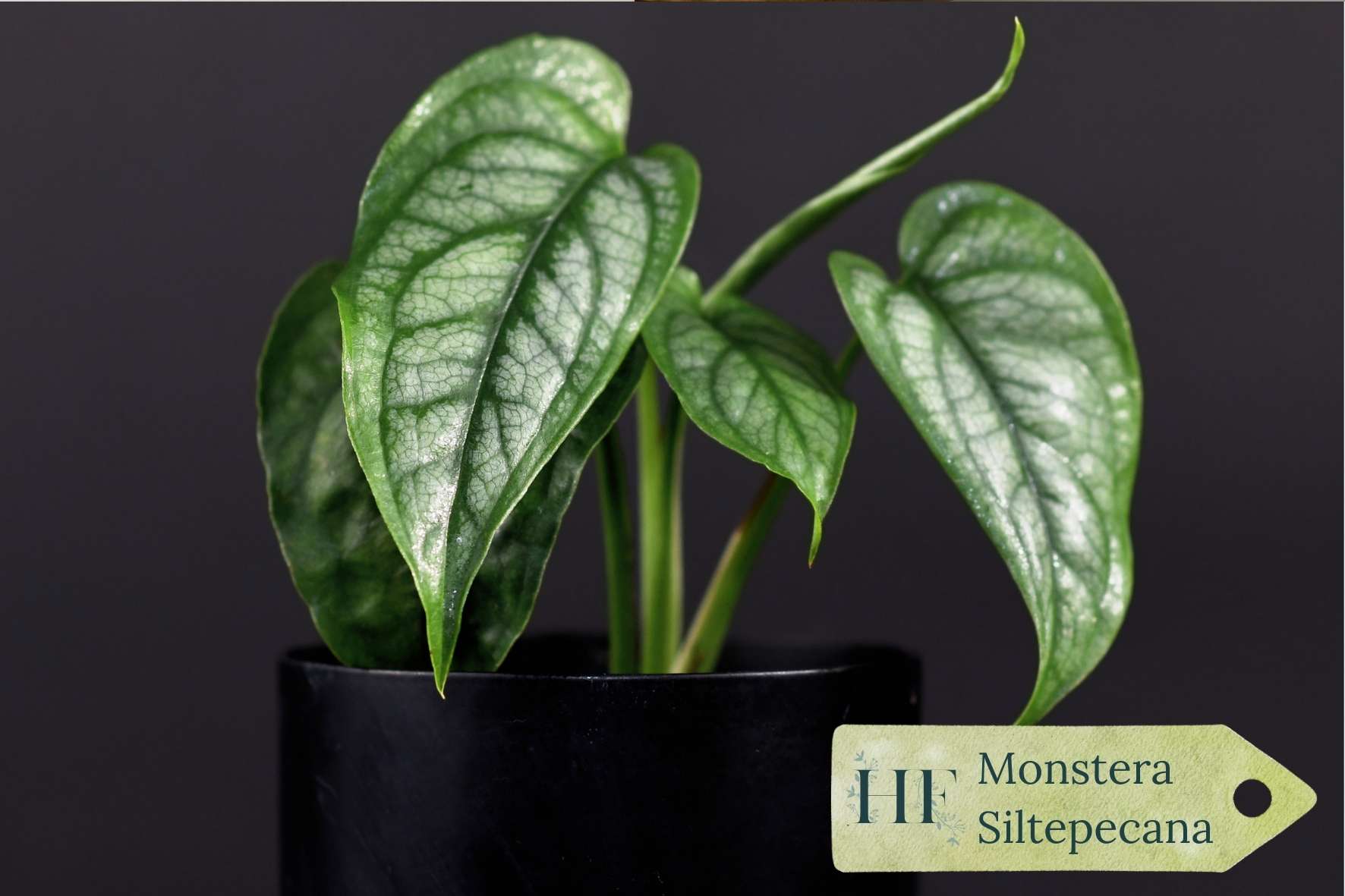
8) Monstera Karstenianum (Monstera Peru)
Monstera Karstenianum is commonly known as Monstera Peru.
Monstera Karstenianum Care
| MONSTERA SPECIES | Monstera Karstenianum |
|---|---|
| Plant Type | Evergreen vine, flowering plant. |
| Geographic Origin | Peru. |
| Plant Size | 6 to 8 feet (1.8 to 2.4m) tall indoors. |
| Flower | Green and white spathe and spadix. |
| USDA Hardiness Zones | 10b to 12b. |
| Soil Type | Loamy, well-drained soil with acidic or neutral pH. |
| Light Requirements | Partial shade. |
| Humidity Levels | 50 to 60% |
| Temperature Needs | 68 to 86°F (20 to 30°C). |
| Watering Needs | Medium (moist soil). |
| Feeding Needs | Fertilize once a month during spring and summer. |
| Toxicity | Toxic to humans, dogs, cats, and other pets. |
Monstera Karstenianum Facts
It has small, leathery, glossy leaves, which have a thicker and wrinkled (or puckered) texture. They are a dark shade of green, oval-shaped and have a pointed end.
Also, Monstera Karstenianum leaves have no fenestrations, this feature differentiates it from other Monstera varieties.
Monstera Peru, like Adansonii, grows as a vine.
See Monstera Karstenianum on Etsy.
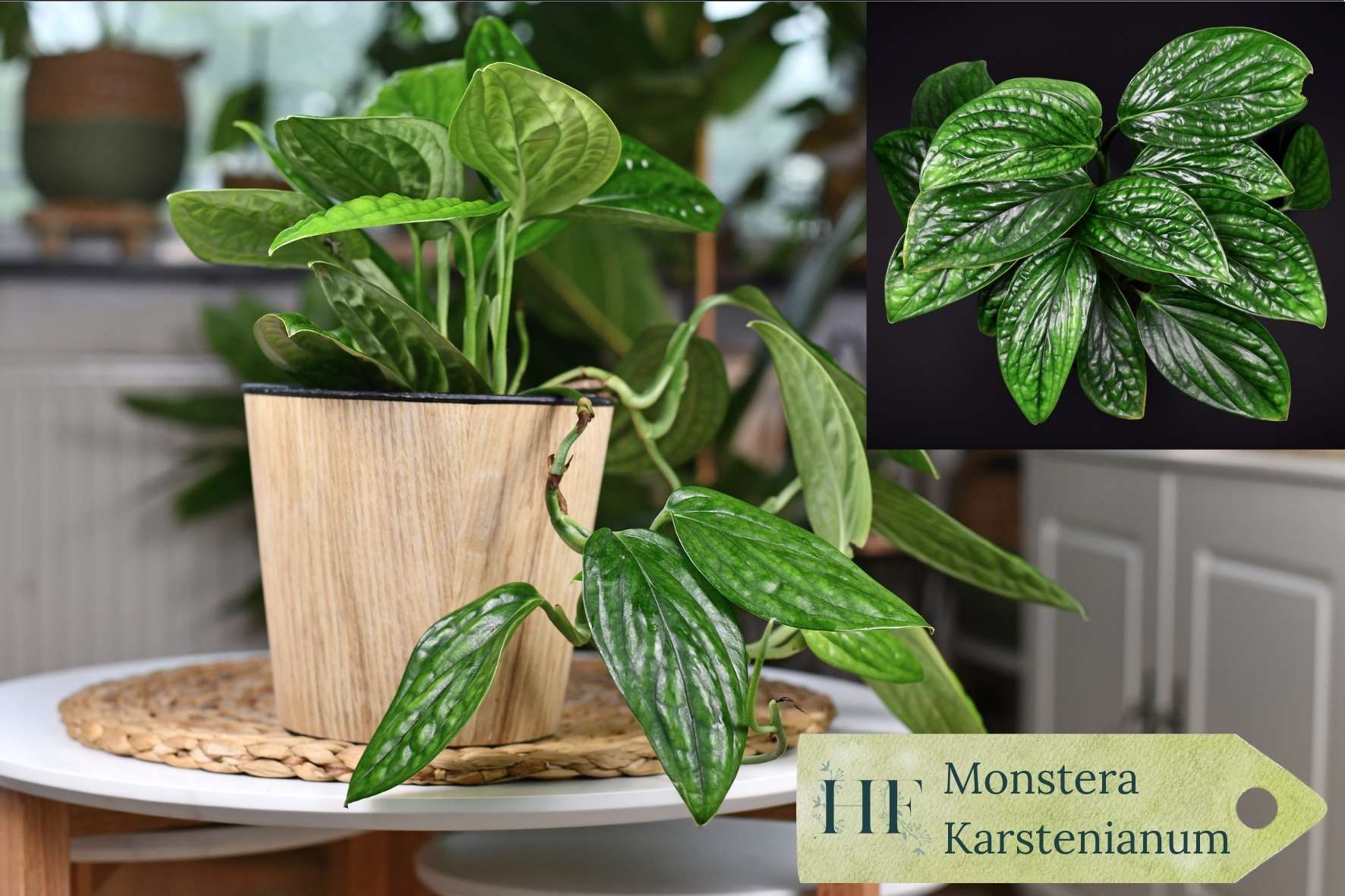
9) Monstera Acuminata (Shingle Plant)
Monstera Acuminata is also known as Shingle Plant.
Monstera Acuminata Care
| MONSTERA SPECIES | Monstera Acuminata |
|---|---|
| Plant Type | Evergreen vine, flowering plant. |
| Geographic Origin | Mexico, Central America. |
| Plant Size | Up to 98 feet (30m) tall outdoors, and up to 8 feet (2.4m) tall indoors. |
| Flower | Cream spathe and spadix. |
| USDA Hardiness Zones | 10 to 12. |
| Soil Type | Well-drained soil. |
| Light Requirements | Full sun to partial sun. |
| Humidity Levels | 50 to 60% |
| Temperature Needs | 68 to 86°F (20 to 30°C). |
| Watering Needs | Medium (moist soil). |
| Feeding Needs | Fertilize once a month during spring and summer. |
| Toxicity | Toxic to humans, dogs, cats, and other pets. |
Monstera Acuminata Facts
Acuminata looks similar to Monstera Adansonii, and it’s considered to be the smaller cousin since its leaves are smaller.
You can tell the difference between them by the shape of Acuminata’s leaves. It has asymmetric leaves, where one side of the leaf is wider than the other.
Also, the wider side tends to have more fenestrations. However, it doesn’t develop holes until it grows to be about a foot (0.3m) long.
A juvenile Acuminata has heart-shaped leaves that are thick, roundish, and waxy. They grow in two ranks and overlap each other.
This variety grows as a “shingle plant” because it lies flat against the surface of a tree. When it’s young, it grows horizontally as a low prostrate herb. It can, however, grow vertically on the tree.
As it matures, it changes its leaf shape and growth habit. A mature Monstera Acuminata develops larger, perforated leaves which no longer adhere to the host tree’s trunk.
The mature leaves are smoother and darker than Adansonii’s. Their length varies from 4 to 10 inches (10 to 25.4cm), and 4 to 5 inches (10 to 12.7cm) wide.
See these Monstera Acuminata selections on Etsy.
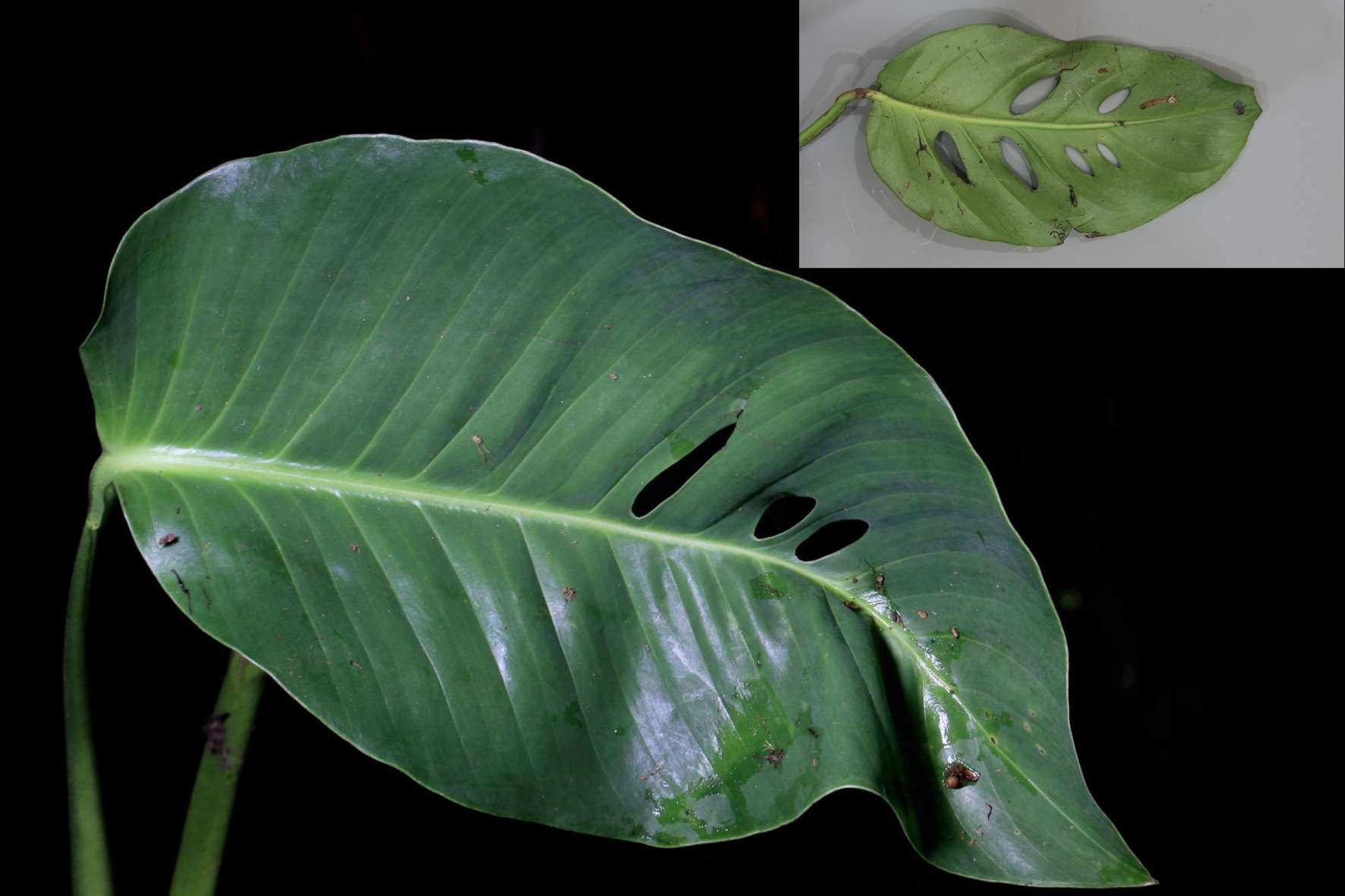
10) Monstera Epipremnoides (Monstera Esqueleto)
Monstera Epipremnoides is also known as Monstera Esqueleto, which translates to ‘skeleton’ in Spanish. This is because the leaf blades look like a rib cage due to the layout of the large fenestrations.
Monstera Epipremnoides Care
| MONSTERA SPECIES | Monstera Epipremnoides |
|---|---|
| Plant Type | Evergreen vine, flowering plant. |
| Geographic Origin | Costa Rica. |
| Plant Size | 7 to 13 feet (2.1 to 4m) tall. |
| Flower | Green and cream spathe and yellowish spadix. |
| USDA Hardiness Zones | 11 to 12. |
| Soil Type | Well-drained soil. |
| Light Requirements | Bright indirect sunlight. |
| Humidity Levels | 50 to 60% |
| Temperature Needs | 68 to 86°F (20 to 30°C). |
| Watering Needs | Medium (moist soil). |
| Feeding Needs | Fertilize once a month during spring and summer. |
| Toxicity | Toxic to humans, dogs, cats, and other pets. |
Monstera Epipremnoides Facts
Esqueleto goes through a huge transformation in maturity but looks similar to Adansonii in its younger stage.
The leaves are dark green and can grow up to 31 inches (78cm) long and 17 inches (43cm) wide.
They have small perforations along the centre rib of the leaf and larger holes that often extend from close to the midrib (or centre rib) to the margin, usually not breaking the margin.
At maturity, the leaves fan out and get a droopy look. They have a soft and floppy texture.
Also, this variety flowers in its natural habitat (or in greenhouses) and produces fruit.
See these Monstera Epipremnoides selections on Etsy.
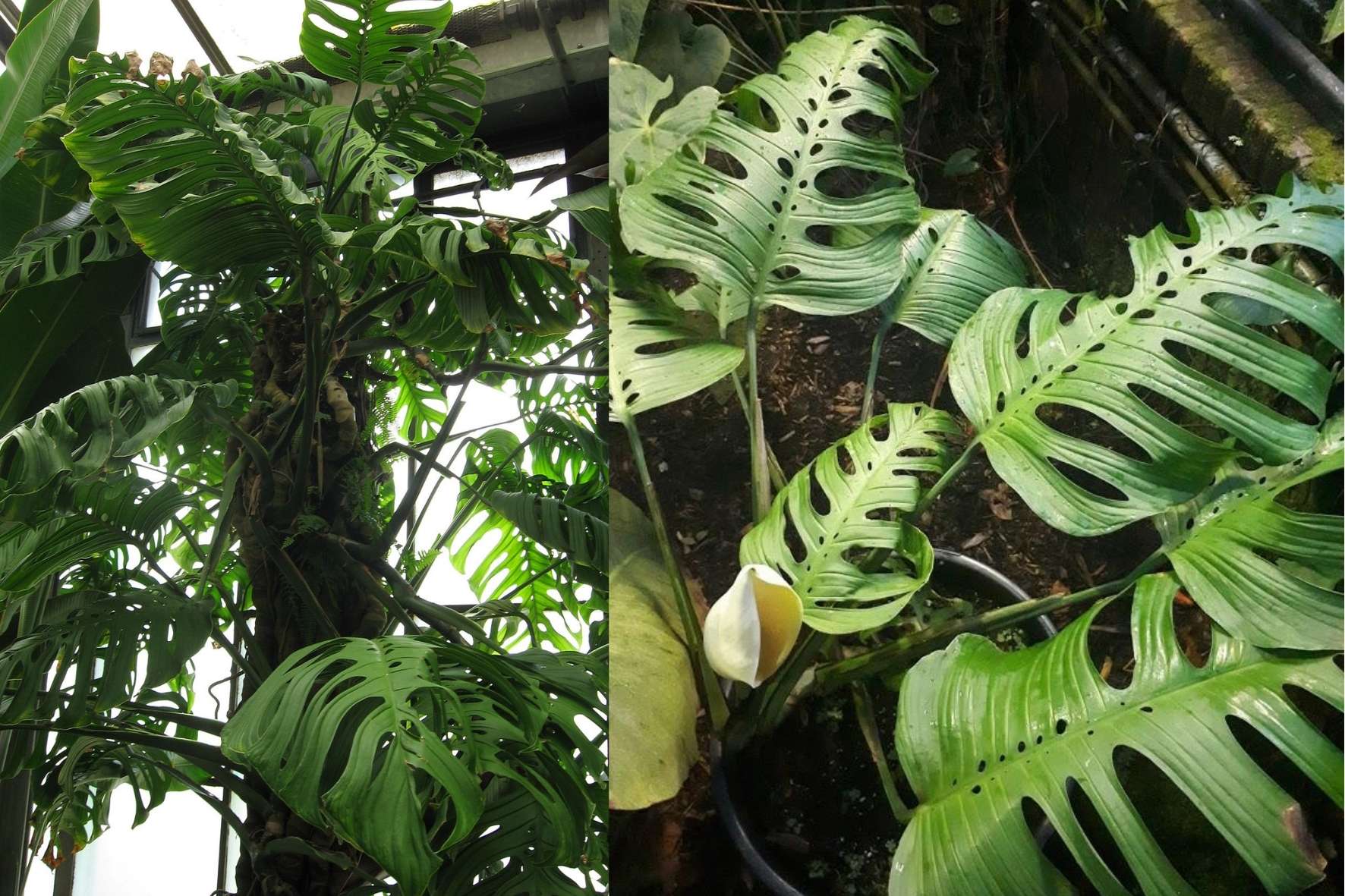
11) Monstera Standleyana (Five Holes Plant)
Monstera Standleyana, also known as the Five Holes Plant, is a naturally variegated Monstera. This variety of Monstera is incredibly rare and often referred to as Philodendron Cobra on seller sites.
Monstera Standleyana Care
| MONSTERA SPECIES | Monstera Standleyana |
|---|---|
| Plant Type | Evergreen vine, flowering plant. |
| Geographic Origin | Costa Rica, Honduras, Nicaragua, Panama. |
| Plant Size | Up to 20 feet (6.1m) tall outdoors, and 2 to 5 feet (0.6 to 1.5m) tall indoors. |
| Flower | Creamy spathe and spadix. |
| USDA Hardiness Zones | 11b to 12. |
| Soil Type | Well-drained soil with acidic to neutral pH. |
| Light Requirements | Bright indirect sunlight, partial shade. |
| Humidity Levels | 50 to 60% |
| Temperature Needs | 68 to 86°F (20 to 30°C). |
| Watering Needs | Medium (moist soil). |
| Feeding Needs | Fertilize once a month during spring and summer. |
| Toxicity | Toxic to humans, dogs, cats, and other pets. |
Monstera Standleyana Facts
Its dark green waxy leaves have small spots and streaks that can be creamy, white, or yellow in colour.
The leaves are long, narrow, and lance-shaped, which makes them very different from the iconic heart-shaped leaf of Monstera Deliciosa. Also, they like to point upward rather than hang down towards the ground.
Like Monstera Karstenianum, Standleyana doesn’t develop fenestrations when reaching its mature size.
Also, Standleyana is a slower-growing variety compared to other Monsteras.
See these Monstera Standleyana selections on Etsy.
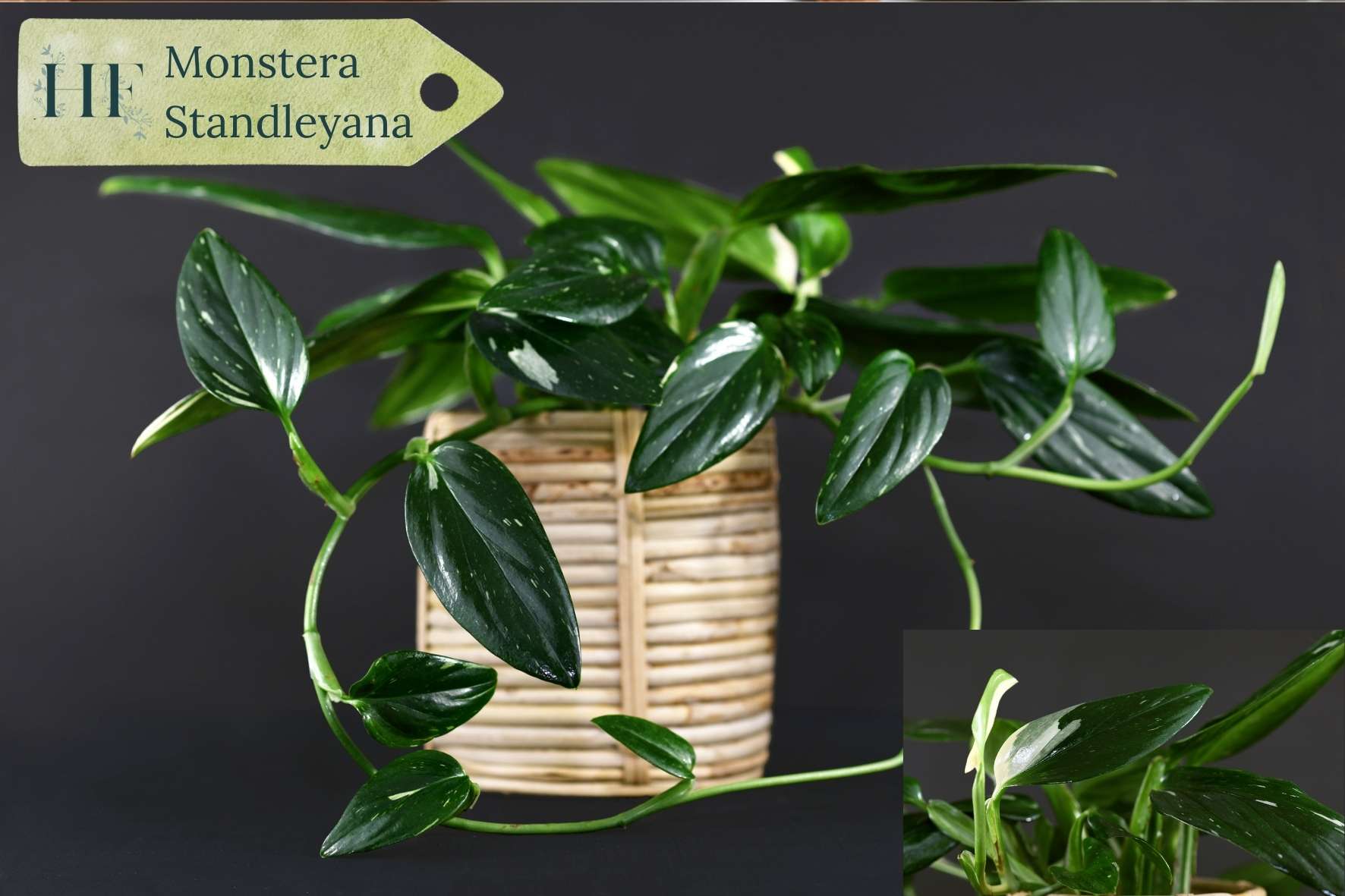
12) Monstera Subpinnata
This is another Monstera species that falls on the rarer side.
Monstera Subpinnata Care
| MONSTERA SPECIES | Monstera Subpinnata |
|---|---|
| Plant Type | Evergreen vine, flowering plant. |
| Geographic Origin | Bolivia, Colombia, Ecuador, Peru. |
| Plant Size | Up to 33 feet (10m) tall outdoors, and 3 to 6 feet (0.9 to 1.8m) tall indoors. |
| Flower | Cream or yellowish pink spathe and yellowish spadix. |
| USDA Hardiness Zones | 10b to 12. |
| Soil Type | Well-drained soil. |
| Light Requirements | Bright indirect sunlight. |
| Humidity Levels | 50 to 60% |
| Temperature Needs | 68 to 86°F (20 to 30°C). |
| Watering Needs | Medium (moist soil). |
| Feeding Needs | Fertilize once a month during spring and summer. |
| Toxicity | Toxic to humans, dogs, cats, and other pets. |
Monstera Subpinnata Facts
Monstera Subpinnata takes the split-leaf fenestration to the next level displaying fanned-out foliage. It’s an example of pinnate foliage, with pairs of leaflets symmetrically on either side of the stem.
It’s similar to a mature Pinnatipartita, but Subpinnata really takes the palm vibes to the extreme for a Monstera species. What I mean is that its foliage almost looks palm-like.
These leaves can reach up to 1 foot (0.3m) long and 8 inches (20.3cm) wide when mature.
It also flowers in its natural habitat.
See these Monstera Subpinnata selections on Etsy.

13) Monstera Acacoyaguensis
Monstera Acacoyaguensis Care
| MONSTERA SPECIES | Monstera Acacoyaguensis |
|---|---|
| Plant Type | Evergreen vine, flowering plant. |
| Geographic Origin | Belize, Guatemala, Mexico. |
| Plant Size | Up to 20 feet (6m) tall outdoors, and 4 to 6 feet (1.2 to 1.8m) tall indoors. |
| Flower | Yellowish to cream spathe and yellowish spadix. |
| USDA Hardiness Zones | 11b to 12. |
| Soil Type | Well-drained soil with acidic to neutral pH. |
| Light Requirements | Bright indirect sunlight. |
| Humidity Levels | 50 to 60% |
| Temperature Needs | 68 to 86°F (20 to 30°C). |
| Watering Needs | Medium (moist soil). |
| Feeding Needs | Fertilize once a month during spring and summer. |
| Toxicity | Toxic to humans, dogs, cats, and other pets. |
Monstera Acacoyaguensis Facts
Monstera Acacoyaguensis has oval-shaped glossy green leaves that have a leathery appearance as a young plant.
As the plant matures, the leaves become larger and fenestrated, with oval-shaped holes. Its leaves can be 24 to 33 inches (60 to 84cm) long and 14 to 18 inches (35 to 45cm) wide.
Monstera Acacoyaguensis looks like a mature Monstera Adansonii, but their fenestrations are different. Usually, the perforations in Acacoyaguensis are in one or two series.
This type of Monstera also flowers in its natural habitat.
See these Monstera Acacoyaguensis selections on Etsy.
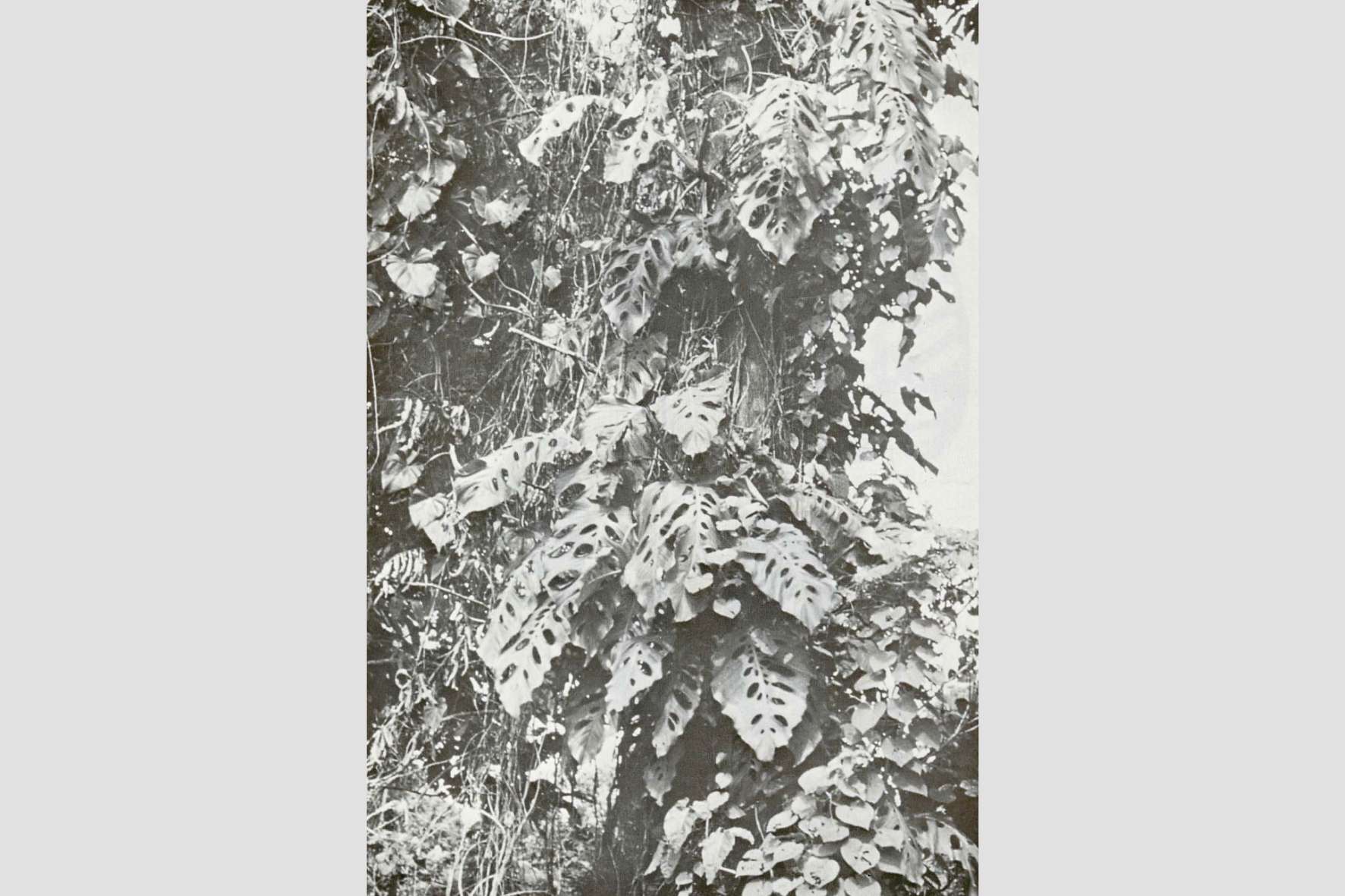
14) Monstera Punctulata
Monstera Punctulata is a rare species and is known thanks to a few collections.
Monstera Punctulata Care
| MONSTERA SPECIES | Monstera Punctulata |
|---|---|
| Plant Type | Evergreen vine, flowering plant. |
| Geographic Origin | Mexico, Central America. |
| Plant Size | Up to 50 feet (15.2m) tall outdoors, and 7 to 10 feet (2.1 to 3m) tall indoors. |
| Flower | White spathe and deep green to greenish-gold spadix. |
| USDA Hardiness Zones | 11 to 12. |
| Soil Type | Well-drained soil with acidic to neutral pH. |
| Light Requirements | Bright indirect sunlight. |
| Humidity Levels | 50 to 60% |
| Temperature Needs | 68 to 86°F (20 to 30°C). |
| Watering Needs | Medium (moist soil). |
| Feeding Needs | Fertilize once a month during spring and summer. |
| Toxicity | Toxic to humans, dogs, cats, and other pets. |
Monstera Punctulata Facts
As a juvenile plant, Monstera Punctulata is a shingle plant (i.e., it lies flat against the surface) and has a flattened stem (unlike its adult stem, which is round and brown in colour).
Its leaves are bright green, with white lateral veins and have a soft texture. Mature leaves are 23.6 to 47.2 inches (60 to 120cm) long and 13.8 to 23.6 (35 to 60 cm) wide. They have an oval to oblong shape.
As the plant matures it produces large leaves with perforations, both holes and slits. Some of those fenestrations extend to and break through the outer edge of the leaf.
Also, the petiole is densely flecked with white spots.
This variety of Monstera also flowers in its natural habitat and produces fruit.
See these Monstera Punctulata selections on Etsy.
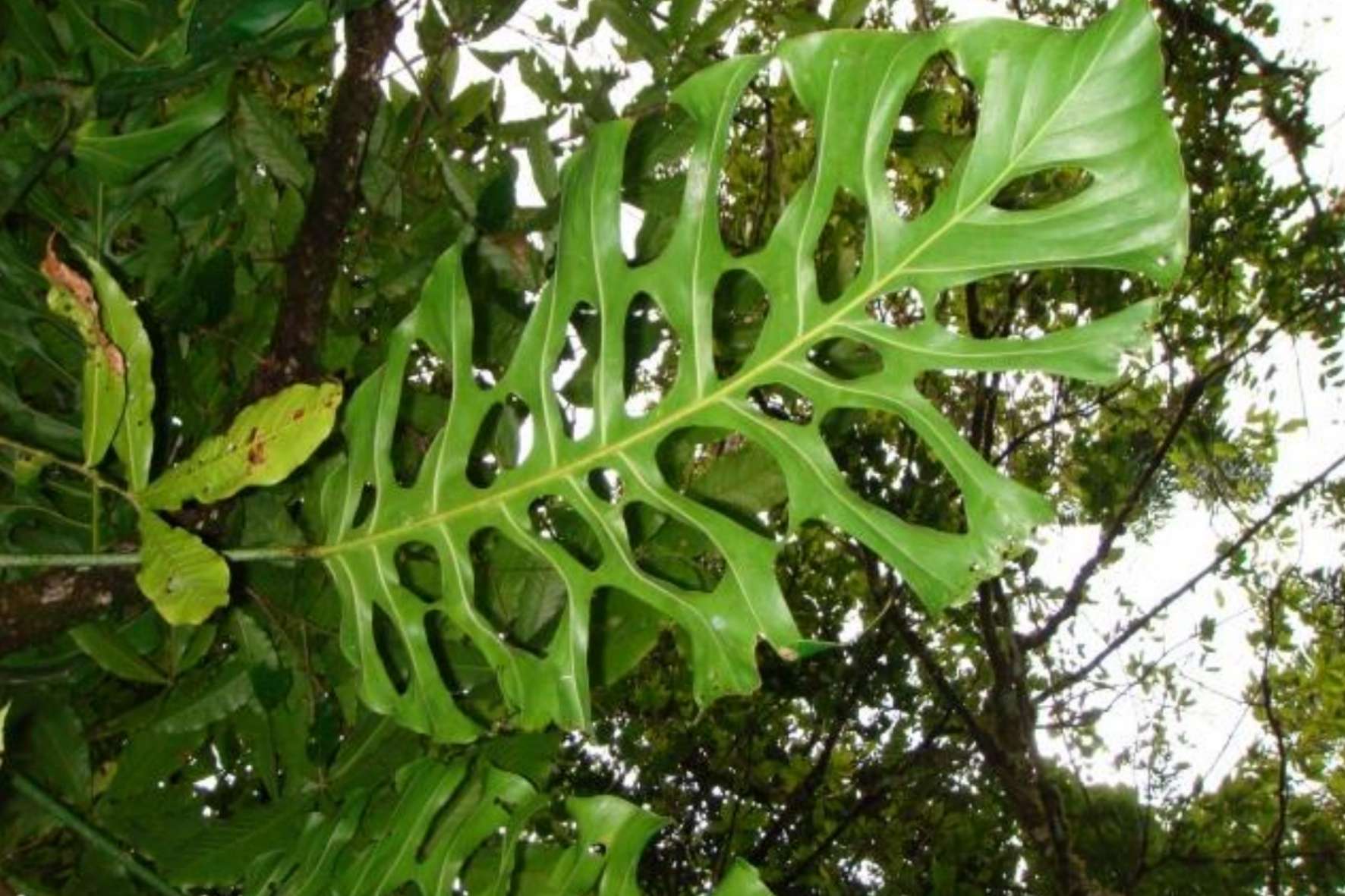
15) Monstera Lechleriana
Monstera Lechleriana Care
| MONSTERA SPECIES | Monstera Lechleriana |
|---|---|
| Plant Type | Evergreen vine, flowering plant. |
| Geographic Origin | Bolivia, Colombia, Ecuador, Panamá, Peru, and Venezuela. |
| Plant Size | Up to 23 feet (7m) tall outdoors, and 4 to 6 feet (1.2 to 1.8m) tall indoors. |
| Flower | Creamy spathe and spadix. |
| USDA Hardiness Zones | 11b to 12. |
| Soil Type | Well-drained soil with acidic to neutral pH. |
| Light Requirements | Bright indirect sunlight. |
| Humidity Levels | 50 to 60% |
| Temperature Needs | 68 to 86°F (20 to 30°C). |
| Watering Needs | Medium (moist soil). |
| Feeding Needs | Fertilize once a month during spring and summer. |
| Toxicity | Toxic to humans, dogs, cats, and other pets. |
Monstera Lechleriana Facts
Monstera Lechleriana has large foliage similar to Adansonii. But the holes of Monstera Lechleriana develop in the centre of the leaves instead, along the centre ridge of the leaf (or midrib).
This variety has oval-shaped leaves that are leathery, glossy green, and have a pale underside. Mature leaves are 30 to 47 inches (0.8 to 1.2m) long, and 14 to 28 inches (35.6 to 71.1cm) wide.
Lechleriana flowers in its natural habitat, and produces fruit.
See these Monstera Lechleriana selections on Etsy.
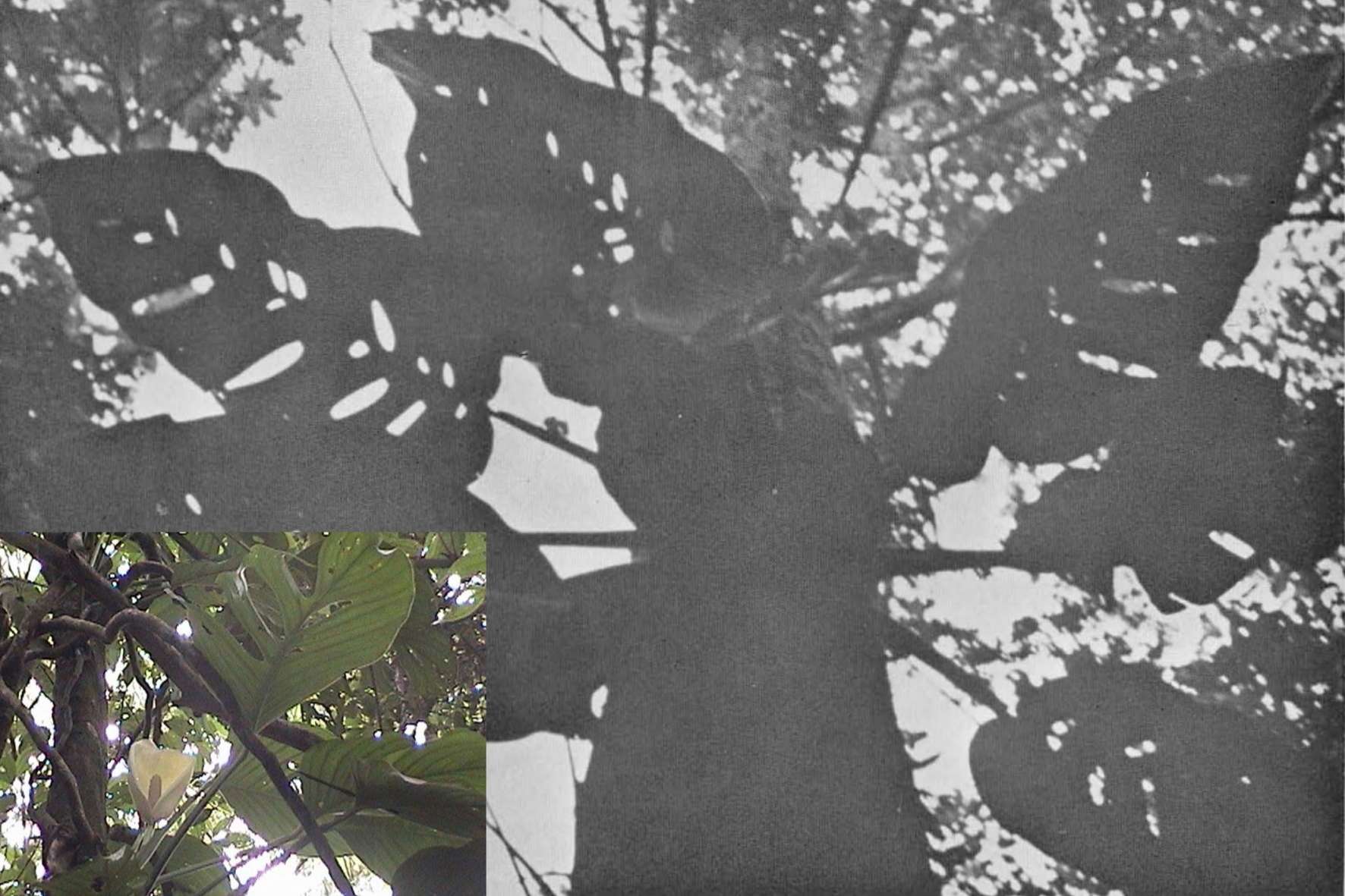
Here are some illustrations about Monstera leaf types to the same scale. On the left illustration, you can see Monstera Deliciosa leaves in different stages of maturity and fenestration. On the right illustration, a variety of Monstera leaves.
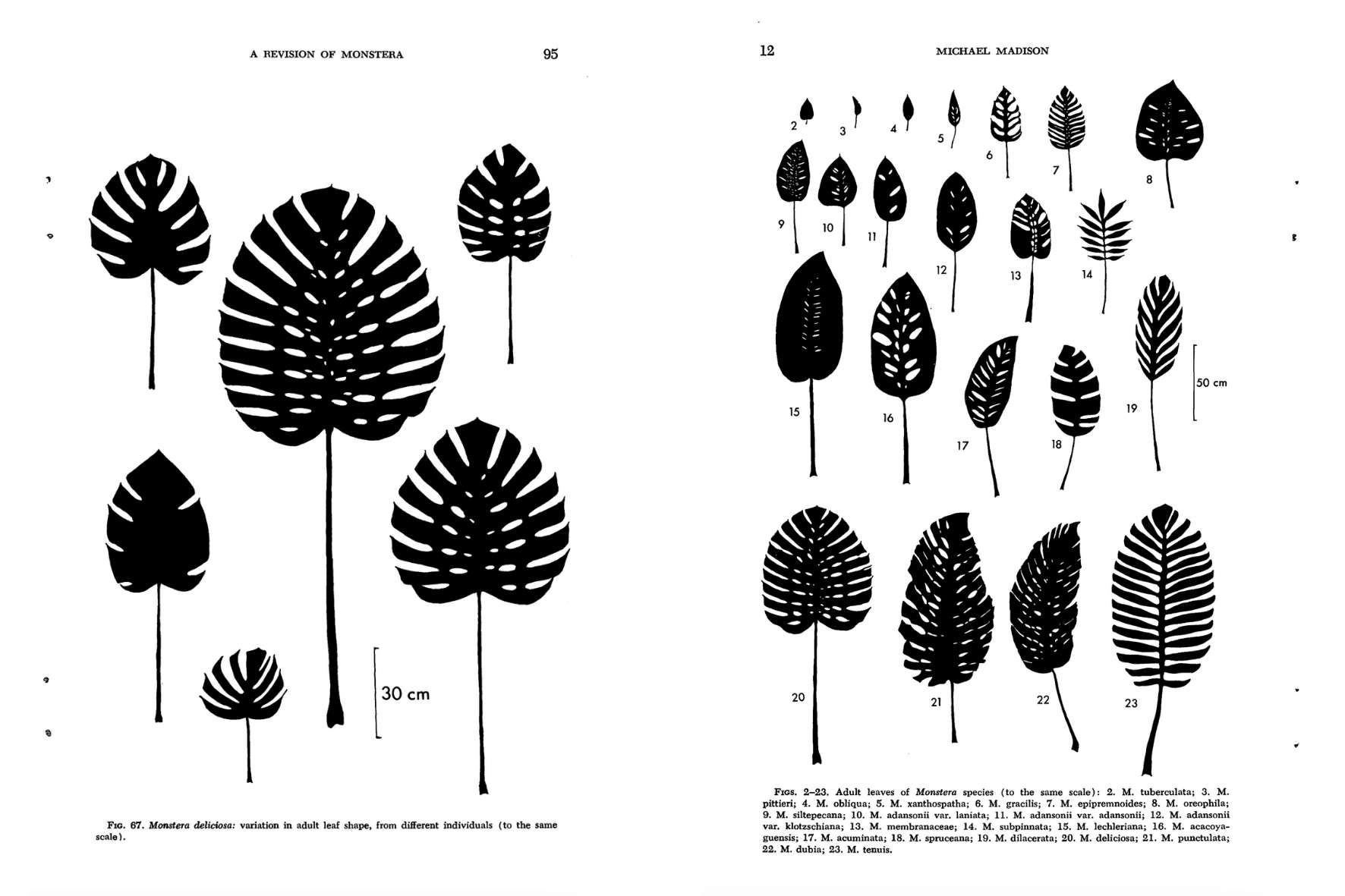
Monstera Cultivars
There are 49 species of Monstera and 6 infraspecific names, i.e., cultivars or subspecies. One of the most known ones is Monstera Variegata.
What is a variegated Monstera?
Variegation in Monstera plants is caused by a genetic mutation that prohibits the plant’s cells from producing chlorophyll (the molecule that gives plants their green colour and captures sunlight) resulting in discolouration in the tissue (creamy-white splashes).
Some plants are naturally variegated due to their DNA, like the snake plant and prayer plant. However, this isn’t the case with all Variegated Monsteras; in some cases, it’s a chemical process.
Read also: What Is a Variegated Monstera? Why Is It So Expensive?
Here are the most known Monstera cultivars:
16) Monstera Deliciosa Variegata
Also known as Albo Variegata, it is one of the most popular (and known) variegated Monsteras.
Monstera Deliciosa Variegata Care
| MONSTERA SPECIES | Monstera Deliciosa Variegata |
|---|---|
| Plant Type | Evergreen vine, flowering plant. |
| Cultivar Origin | Monstera Deliciosa. |
| Plant Size | Up to 6 feet (1.8m) tall indoors. |
| Flower | (No data since only grown as a houseplant). |
| USDA Hardiness Zones | 10 to 12. H1B in the UK. |
| Soil Type | Well-drained soil. |
| Light Requirements | Bright indirect sunlight, partial shade. |
| Humidity Levels | 40 to 60% |
| Temperature Needs | 68 to 86°F (20 to 30°C). |
| Watering Needs | Medium (moist soil). |
| Feeding Needs | Fertilize once a month during spring and summer. |
| Toxicity | Toxic to humans, dogs, cats, and other pets. |
Monstera Deliciosa Variegata Facts
Monstera Deliciosa Variegata is caused by natural mutation. This type of variegation occurs naturally due to genetic mutation after germination and is not stable.
This cultivar has patches of white or cream on its leaves. It can also have leaves that are half green and half white, giving it the Monstera half-moon look.
See these Monstera Deliciosa Variegata selections on Etsy.
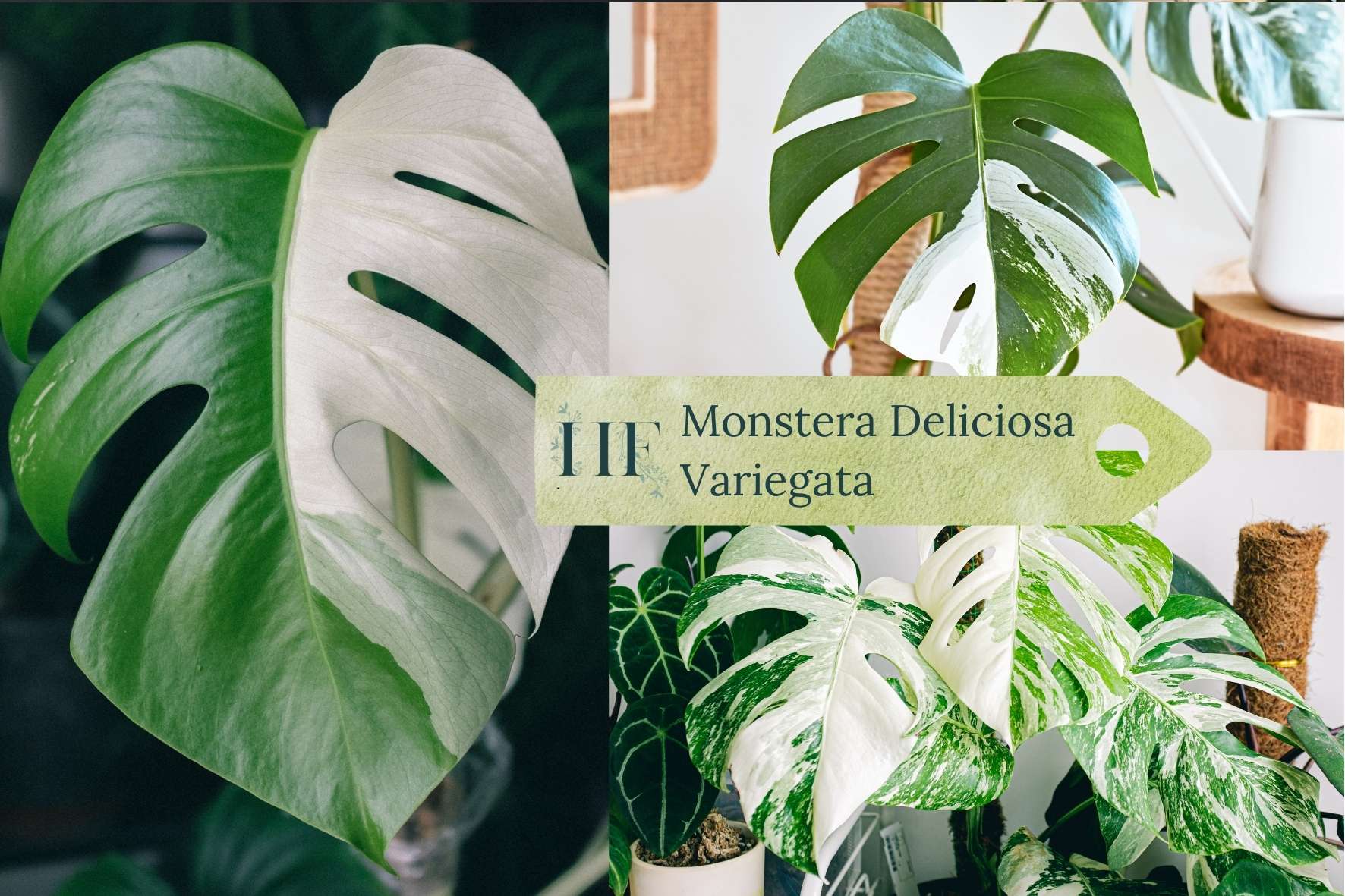
17) Monstera Deliciosa Thai Constellation
The plant was first produced via tissue culture by a lab in Thailand, hence its name.
Monstera Deliciosa Thai Constellation Care
| MONSTERA SPECIES | Monstera Deliciosa Thai Constellation |
|---|---|
| Plant Type | Evergreen vine, flowering plant. |
| Cultivar Origin | Monstera Deliciosa, variegation produced in a lab in Thailand. |
| Plant Size | Up to 6 feet (1.8m) tall indoors. |
| Flower | (No data since only grown as a houseplant). |
| USDA Hardiness Zones | 10 to 12. H1B in the UK. |
| Soil Type | Well-drained soil. |
| Light Requirements | Bright indirect sunlight, partial shade. |
| Humidity Levels | 40 to 60% |
| Temperature Needs | 68 to 86°F (20 to 30°C). |
| Watering Needs | Medium (moist soil). |
| Feeding Needs | Fertilize once a month during spring and summer. |
| Toxicity | Toxic to humans, dogs, cats, and other pets. |
Monstera Deliciosa Thai Constellation Facts
As a tissue cultured plant, the variegation is very stable and the new leaves will inherit it as they grow.
It’s also named after splotches of creamy white that resemble a stary sky.
Most of the leaves (if not all) will have some type of variegation on them. This is a distinguishing characteristic as most of the other variegated Monstera varieties display both variegated and non-variegated leaves.
See these Monstera Deliciosa Thai Constellation selections on Etsy.
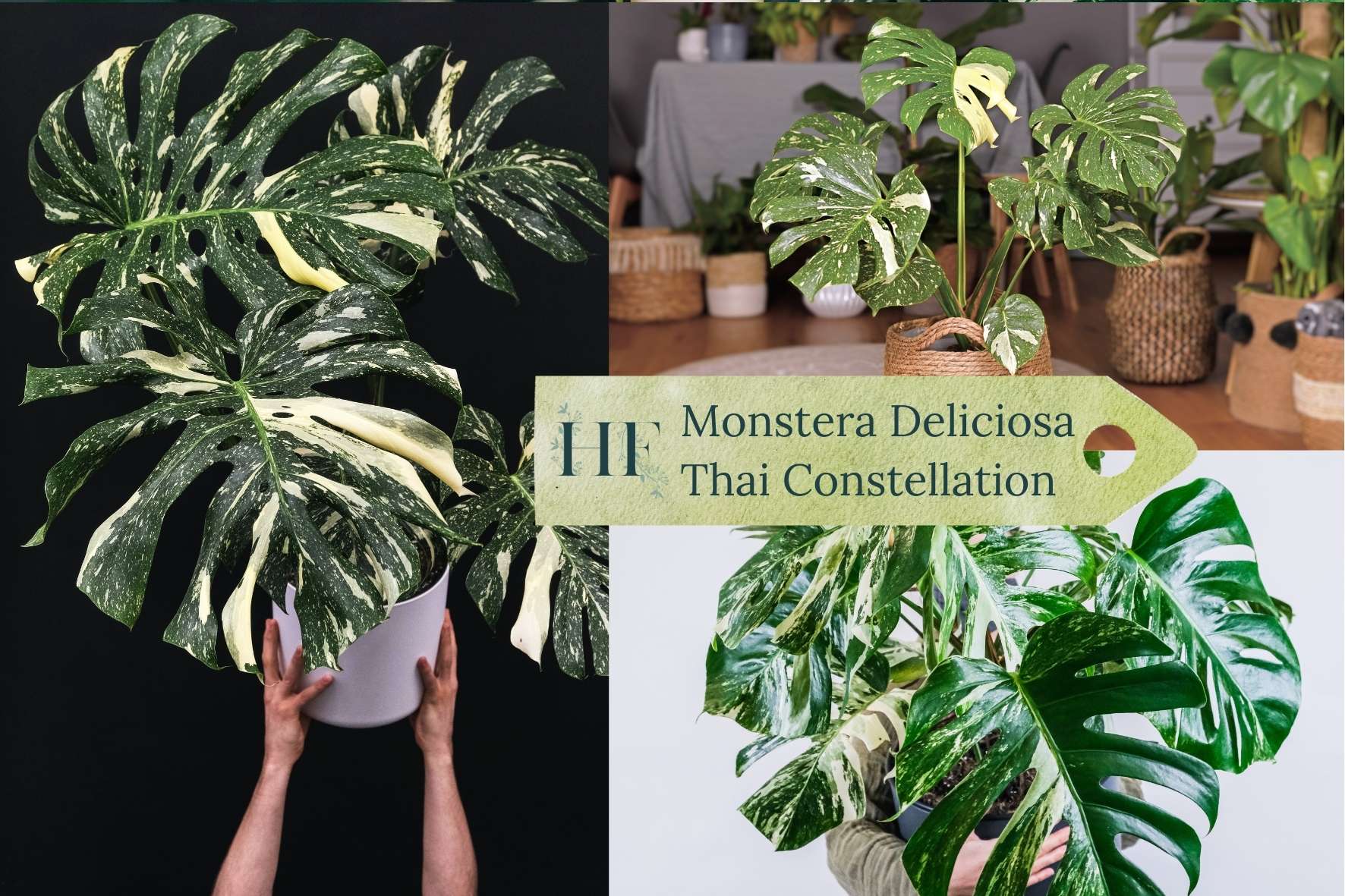
18) Monstera Deliciosa Albo Borsigiana
Borsigiana is actually a subspecies of Monstera Deliciosa. Albo Borsigiana is the variegated form of the Monstera Borsigiana.
Monstera Deliciosa Albo Borsigiana Care
| MONSTERA SPECIES | Monstera Deliciosa Albo Borsigiana |
|---|---|
| Plant Type | Evergreen vine, flowering plant. |
| Cultivar Origin | Monstera Borsigiana (which is a subspecies of Monstera Deliciosa). |
| Plant Size | Up to 6 feet (1.8m) tall indoors. |
| Flower | (No data since only grown as a houseplant). |
| USDA Hardiness Zones | 10 to 11. |
| Soil Type | Well-drained soil. |
| Light Requirements | Bright indirect sunlight, partial shade. |
| Humidity Levels | 40 to 60% |
| Temperature Needs | 68 to 86°F (20 to 30°C). |
| Watering Needs | Medium (moist soil). |
| Feeding Needs | Fertilize once a month during spring and summer. |
| Toxicity | Toxic to humans, dogs, cats, and other pets. |
Monstera Deliciosa Albo Borsigiana Facts
Albo Borsigiana leaves are a bit smaller than other variegated varieties of Monstera Deliciosa. Its leaves are dark green with patches of white.
The variegation on Albo Borsigiana is also natural and it will show as large patches of white on the leaves. These patches are unstable and can turn back to green.
See these Monstera Deliciosa Albo Borsigiana selections on Etsy.
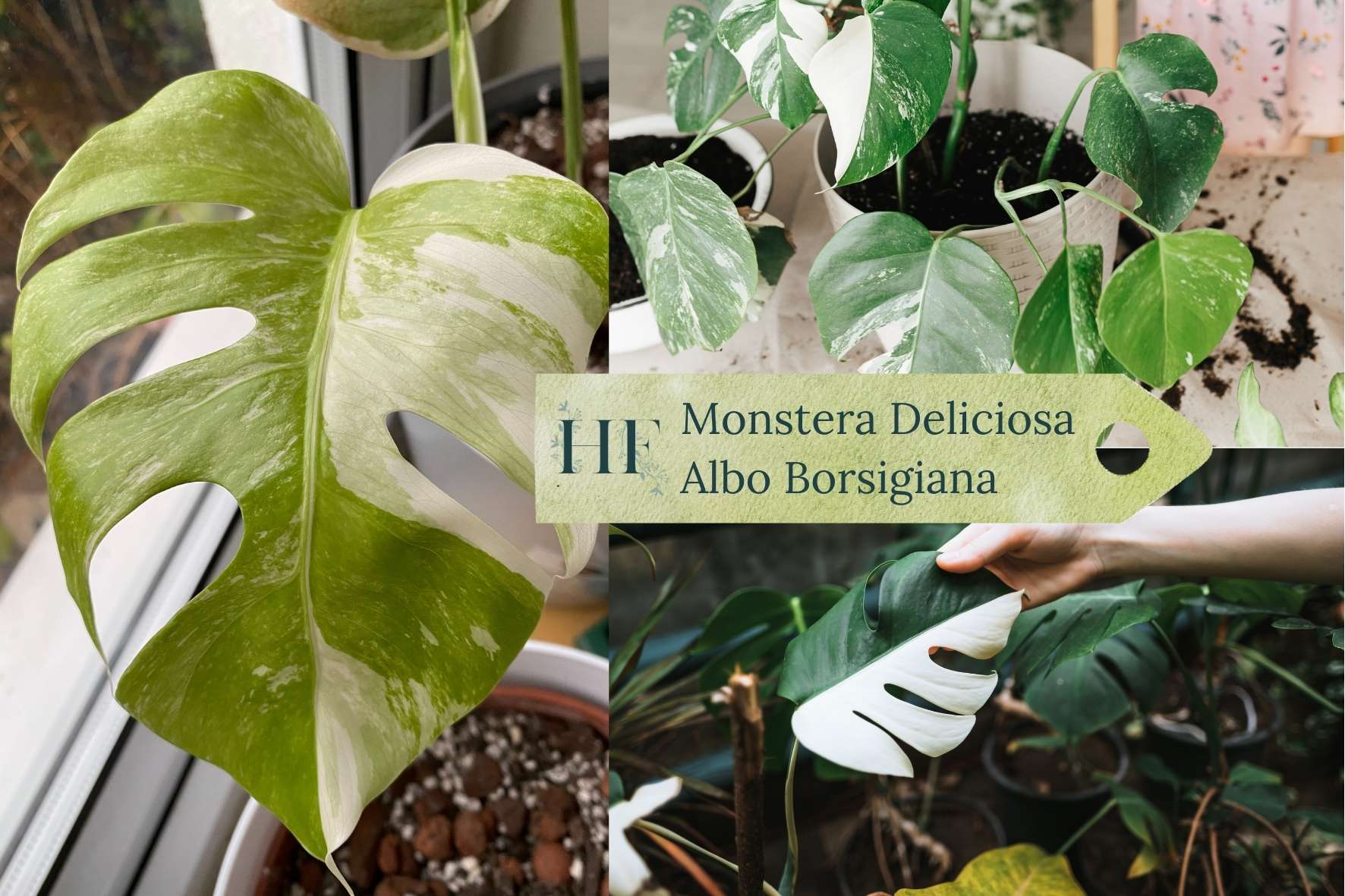
19) Monstera Deliciosa Aurea (or Marmorata)
Monstera Deliciosa Aurea is also known as Monstera Deliciosa Marmorata.
Monstera Deliciosa Aurea Care
| MONSTERA SPECIES | Monstera Deliciosa Aurea (or Marmorata) |
|---|---|
| Plant Type | Evergreen vine, flowering plant. |
| Cultivar Origin | Monstera Deliciosa. |
| Plant Size | Up to 6 feet (1.8m) tall indoors. |
| Flower | (No data since only grown as a houseplant). |
| USDA Hardiness Zones | 10 to 12. |
| Soil Type | Well-drained soil. |
| Light Requirements | Bright indirect sunlight, partial shade. |
| Humidity Levels | 40 to 60% |
| Temperature Needs | 68 to 86°F (20 to 30°C). |
| Watering Needs | Medium (moist soil). |
| Feeding Needs | Fertilize once a month during spring and summer. |
| Toxicity | Toxic to humans, dogs, cats, and other pets. |
Monstera Deliciosa Aurea Facts
It has a colour combination of dark green and yellow. Like the Albo varieties, the yellow variegations can occur on small patches of tissue or on half of the leaf.
The variegation resembles those of a Golden Pothos plant.
Monstera Aurea typically has less variegation on the leaves than other variegated Monstera varieties and some leaves can develop without any variegation at all. Also, its variegation is unstable.
This cultivar of Monstera Deliciosa is extremely rare, which is reflected in its high price.
See these Monstera Deliciosa Aurea selections on Etsy.
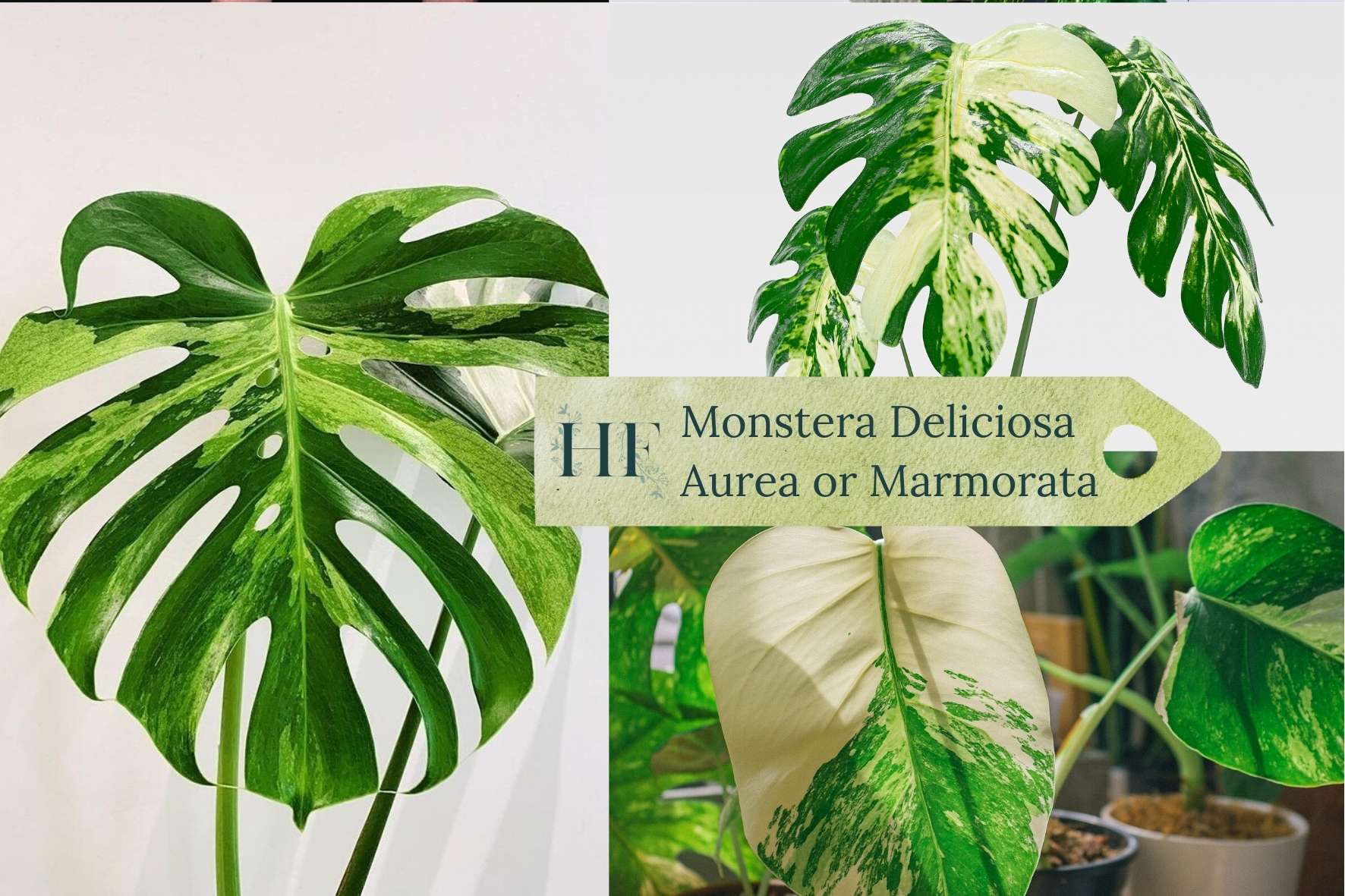
20) Mint Monstera
Monstera Mint is very rare, with not much widely known about this particular cultivar.
Mint Monstera Care
| MONSTERA SPECIES | Mint Monstera |
|---|---|
| Plant Type | Evergreen vine. |
| Cultivar Origin | Monstera Noid. |
| Plant Size | Up to 6 feet (1.8m) tall indoors. |
| Flower | None. |
| USDA Hardiness Zones | (No data since only grown as a houseplant). |
| Soil Type | Well-drained soil. |
| Light Requirements | Bright indirect sunlight, partial shade. |
| Humidity Levels | 40 to 60% |
| Temperature Needs | 68 to 86°F (20 to 30°C). |
| Watering Needs | Medium (moist soil). |
| Feeding Needs | Fertilize once a month during spring and summer. |
| Toxicity | Toxic to humans, dogs, cats, and other pets. |
Mint Monstera Facts
Instead of white, cream, or yellow variegations, it has light mint green colouring mixed in with the traditional dark green of a Monstera.
The mint green variegation is not always consistent across the whole plant, and bright white variegation often occurs throughout the leaves as well.
Also, this cultivar can appear to have variegation which is traditional Albo like, but eventually, grow into the classic mint veining or show it when the plant reaches maturity.
It has deep fenestrations, with only secondary fenestrations ever visible. However, they appear well into maturity.
See these Mint Monstera selections on Etsy.
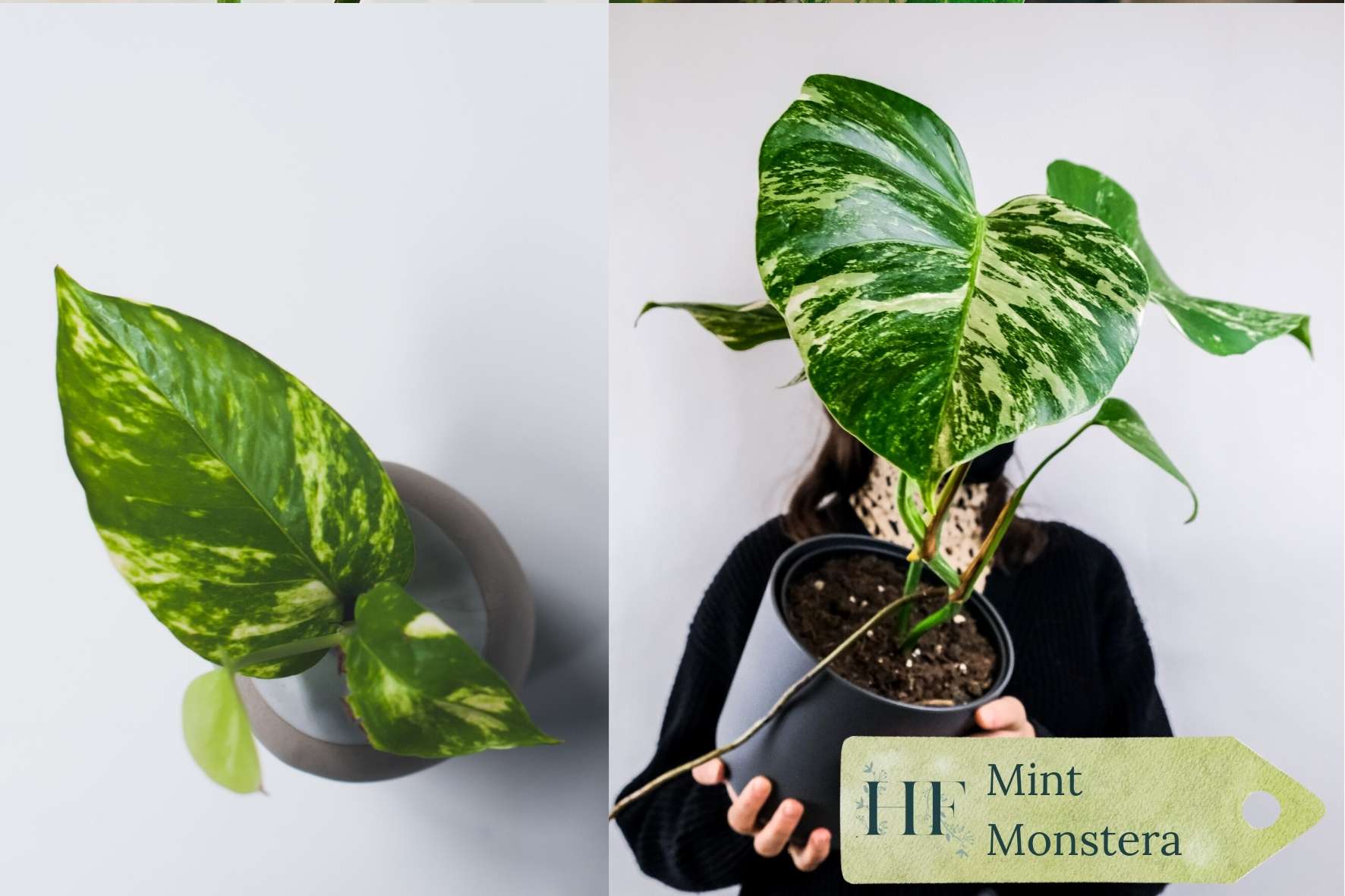
21) Monstera Karstenianum Variegata (Monstera Peru Variegata)
Monstera Karstenianum Variegata is also known as Monstera Peru Variegata.
Monstera Karstenianum Variegata Care
| MONSTERA SPECIES | Monstera Karstenianum Variegata |
|---|---|
| Plant Type | Evergreen vine, flowering plant. |
| Cultivar Origin | Monstera Karstenianum. |
| Plant Size | 6 to 8 feet (1.8 to 2.4m) tall indoors. |
| Flower | (No data since only grown as a houseplant). |
| USDA Hardiness Zones | 10b to 12b. |
| Soil Type | Loamy, well-drained soil with acidic or neutral pH. |
| Light Requirements | Partial shade. |
| Humidity Levels | 50 to 60% |
| Temperature Needs | 68 to 86°F (20 to 30°C). |
| Watering Needs | Medium (moist soil). |
| Feeding Needs | Fertilize once a month during spring and summer. |
| Toxicity | Toxic to humans, dogs, cats, and other pets. |
Monstera Karstenianum Variegata Facts
The origin of its variegation was a spontaneous cellular mutation, also referred to as a mutated chimaera. This means that the variegation is unstable.
Karstenianum Variegata has thick, dark green leaves with a white, yellow or light green variegation. This cream to light green variegation has different patterns on the leaves.
Like Monstera Peru, its variegated cultivar won’t develop any fenestrations (no matter how mature the plant is).
See these Monstera Karstenianum Variegata selections on Etsy.
22) Monstera Adansonii Variegata Archipelago
Adansonii Archipelago, also known as Monkey Mask Variegata, is a rare cultivar.
Monstera Adansonii Archipelago Care
| MONSTERA SPECIES | Monstera Adansonii Variegata Archipelago |
|---|---|
| Plant Type | Evergreen vine, flowering plant. |
| Cultivar Origin | Monstera Adansonii. |
| Plant Size | 3 to 5 feet (0.9 to 1.5m) tall indoors. |
| Flower | (No data since only grown as a houseplant). |
| USDA Hardiness Zones | 11b to 12. |
| Soil Type | Well-drained soil with acidic pH. |
| Light Requirements | Bright indirect sunlight, partial sun. |
| Humidity Levels | 40 to 60% |
| Temperature Needs | 68 to 86°F (20 to 30°C). |
| Watering Needs | Medium (moist soil). |
| Feeding Needs | Fertilize once a month during spring and summer. |
| Toxicity | Toxic to humans, dogs, cats, and other pets. |
Monstera Adansonii Archipelago Facts
Adansonii Archipelago variegation was caused by a random mutation in someone’s houseplant Monstera in Sweden, and her plant is the original mother plant of all subsequent generations.
As a naturally occurring variegation, it’s unstable, which means that it can disappear.
It has a white to cream variegation. Sometimes, due to the variegation, a leaf can turn almost white.
See these Monstera Adansonii Variegata Archipelago selections on Etsy.

Not True Monsteras
Finally, I thought it would be relevant to mention two other plants that are commonly misidentified as Monstera:
- Rhaphidophora Tetrasperma.
- Thaumatophyllum Bipinnatifidum.
Rhaphidophora Tetrasperma (Mini Monstera)
Rhaphidophora Tetrasperma is also known as Mini Monstera, Ginny Philodendron, or Philodendron Piccolo.
Also, it can be confused with Monstera Minima, a Monstera species native to Colombia and Panamá.
Rhaphidophora Tetrasperma Care
| SPECIES | Rhaphidophora Tetrasperma |
|---|---|
| Plant Type | Evergreen vine, flowering plant. |
| Geographic Origin | Thailand and Malaysia. |
| Plant Size | 15 to 20 feet (4.6 to 6.1m) tall outdoors, and 6 to 8 feet (1.8 to 2.4m) tall indoors. |
| Flower | Canoe-shaped spathe that encloses a spadix which bears the clusters of small flowers. |
| USDA Hardiness Zones | 9b to 12b. |
| Soil Type | Well-drained soil with an acidic or neutral pH. |
| Light Requirements | Bright indirect sunlight. |
| Humidity Levels | 50 to 60% |
| Temperature Needs | 55°F to 85°F (12 to 29°C). |
| Watering Needs | Medium (moist soil). |
| Feeding Needs | Fertilize once a month during spring and summer. |
| Toxicity | Toxic to humans, dogs, cats, and other pets. |
Rhaphidophora Tetrasperma Facts
Not only does its common name cause it to misidentify as a Monstera variety, but its appearance also bears a considerable resemblance to Monstera Deliciosa.
Rhaphidophora Tetrasperma is part of the family Araceae, like Monsteras, but the genus is Rhaphidophora.
Its green leaves are 6 to 8 inches (15.2 to 20.3cm) long and have fenestrations that look like wide slits.
This plant flowers in its natural habitat, but not when grown as a houseplant.
See these Rhaphidophora Tetrasperma selections on Etsy.
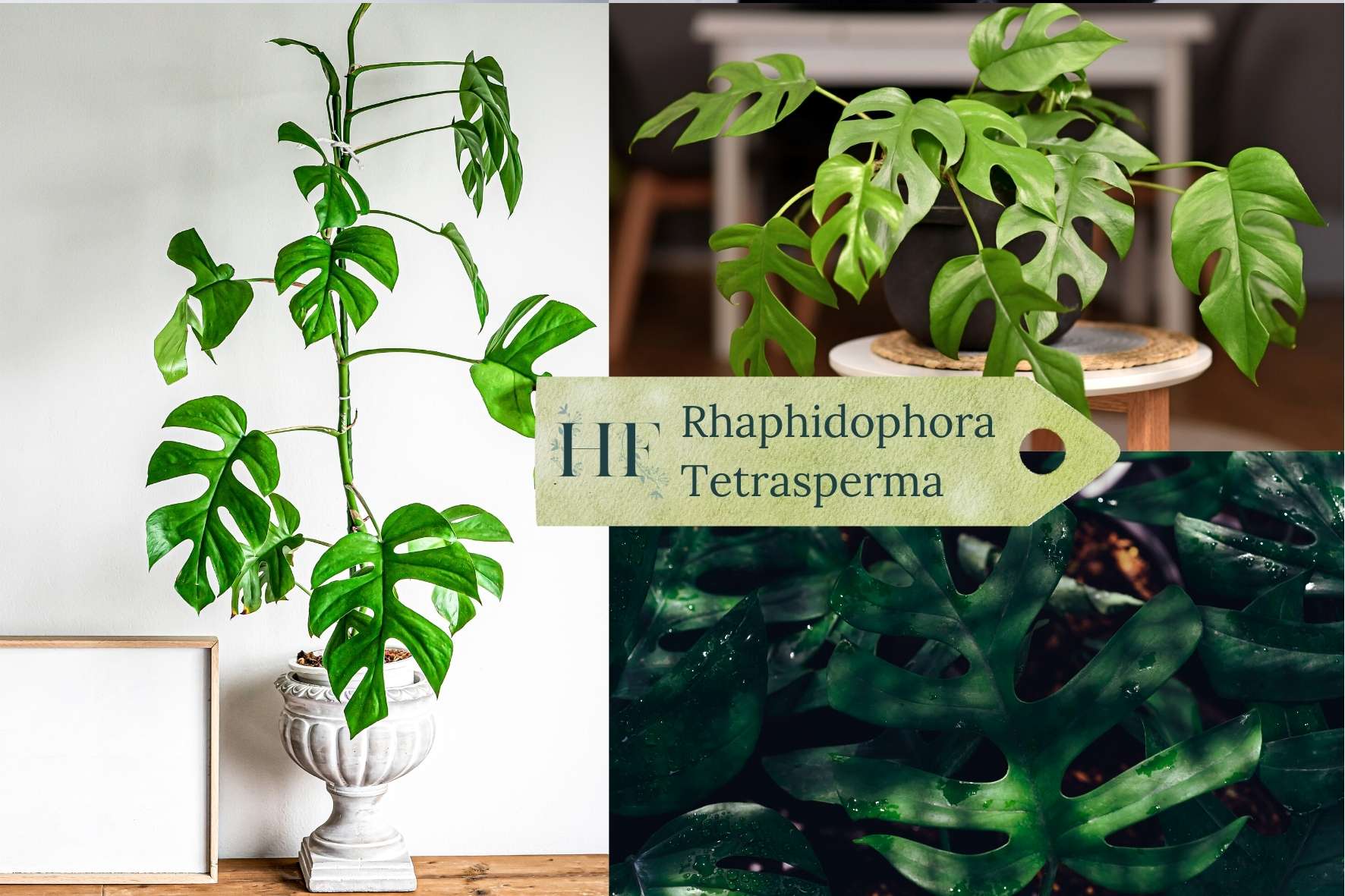
Thaumatophyllum Bipinnatifidum (Split Leaf Philodendron)
Thaumatophyllum Bipinnatifidum is also known as Philodendron Bipinnatifidum, Philodendron Selloum, Horsehead Philodendron and Split Leaf Philodendron (amongst other common names).
Thaumatophyllum Bipinnatifidum Care
| SPECIES | Thaumatophyllum Bipinnatifidum |
|---|---|
| Plant Type | Evergreen, flowering plant. |
| Geographic Origin | Brazil, Bolivia, Argentina, and Paraguay. |
| Plant Size | Up to 15 feet (4.6m) tall outdoors, and up to 6 feet (1.8m) tall indoors. |
| Flower | Purple and cream spathe that encloses a spadix. |
| USDA Hardiness Zones | 9a to 11b. H2 in the UK. |
| Soil Type | Loamy, well-drained soil, with acid, alkaline, or neutral pH. |
| Light Requirements | Medium to bright indirect sunlight, partial shade. |
| Humidity Levels | 70 to 80% |
| Temperature Needs | 60 to 75ºF (16 to 24ºC). |
| Watering Needs | Medium (moist soil). |
| Feeding Needs | Fertilize once a month during spring and summer. |
| Toxicity | Toxic to humans, dogs, cats, and other pets. |
Thaumatophyllum Bipinnatifidum Facts
Thaumatophyllum Bipinnatifidum is part of the family Araceae, like Monsteras, but the genus is Thaumatophyllum.
It has bright green and large leaves that are deeply lobed (i.e., leaves have distinct protrusions, either rounded or pointed). They grow to a size of 2 to 5 feet (0.6 to 1.5m) long.
Like all Monsteras that have flowers, Split Leaf Philodendron blooms in its natural habitat, but not when grown as a houseplant.
See these Thaumatophyllum Bipinnatifidum selections on Etsy.
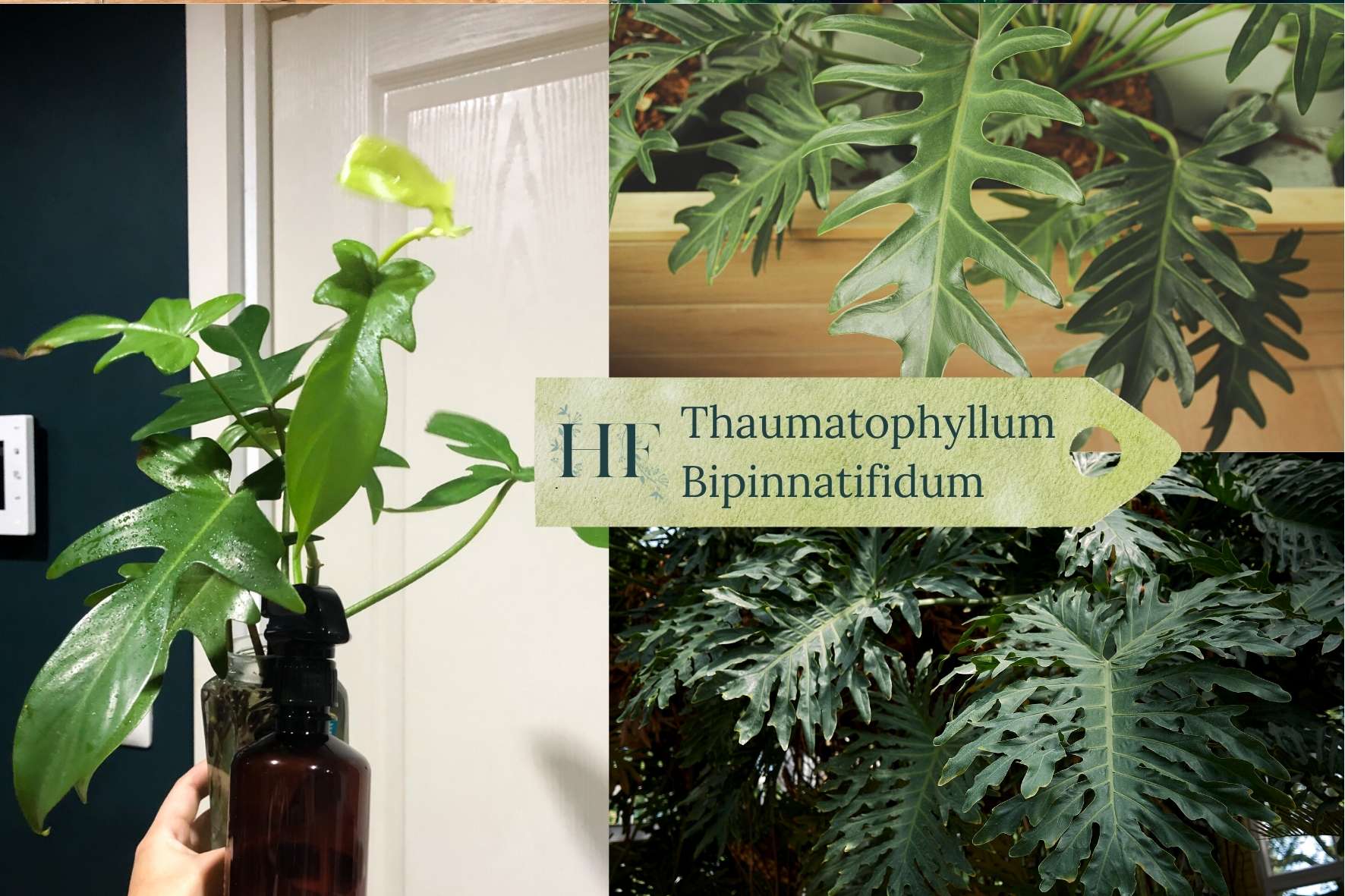
Comment below and let me know what Monstera varieties do you have in your houseplant collection 🙂

